Paul van Yperen's Blog, page 447
August 17, 2013
Lotte Lorring
German actress and singer Lotte Lorring (1893-1939) started as an operetta singer in provincial theatres. Between 1920 and 1935, she played both in support and leading roles in German silent and sound films. Incidentally she appeared in international productions.

Austrian postcard by Iris Verlag, no. 854. Photo: Sascha.
Interesting Directors
Lotte Lorring was born in Berlin, Germany in 1893. First she worked in provincial theatres and she made a name for herself as an operetta singer. In 1919 she made her film debut in Sein letzter Trick/His Last Trick (Rolf Brunner, 1919) with Heinrich Peer and Ernst Pittschau. She then appeared in Der Meisterschuss/The Master Shot (Rolf Brunner, 1920) and Es bleibt in der Familie/It Runs in the Family (Gerhard Lamprecht, 1920), starring Paul Heidemann.
In France, she played in L’ouragan sur la montagne/The Hurricane on the Mountain (Julien Duvivier, 1921) and Le logis de l'horreur/The Sinister Guest (Julien Duvivier, 1921), in which she played the female lead. During the second half of the 1920s, she worked with interesting directors in films like Das graue Haus/The Gray House (Friedrich Feher, 1926) with Magda Sonja, Eine Dubarry von heute/A Modern Dubarry (Alexander Korda, 1926) starring Maria Corda, and Königin Luise.1. Teil: Die jungend der königin Luise/Queen Louise (Karl Grune, 1927).
Lorring co-starred opposite Harry Piel in the comedy Sein größter Bluff/The Big Bluff (Henrik Galeen, Harry Piel, 1927), and opposite Mady Christians in Fräulein Chauffeur/Miss Chauffeur (Jaap Speyer, 1928). In Austria, she appeared for Sascha-Film in Wem gehört meine Frau?/Whom belongs my wife? (Hans Otto, 1929), starring Fritz Kampers.
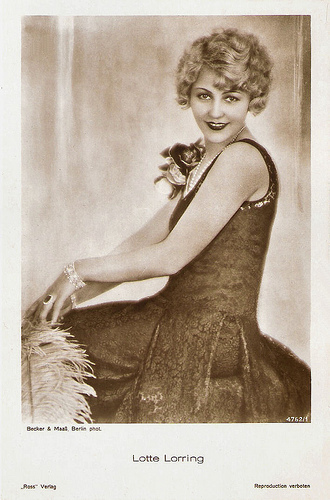
German postcard by Ross Verlag, no. 4762/1, 1929-1930. Photo: Becker & Maass, Berlin.
Paramount
Lotte Loring played the lead in her first sound film, Karriere/Career (Adolf Trotz, 1930) with Walter Rilla. For Paramount, she played in the German-language comedy Ich heirate meinen Mann/I'm marrying my husband (E.W. Emo, 1931), an alternate-language version of Her Wedding Night (Frank Tuttle, 1930).
In the first years of the sound era, she played in some ten films, but soon her roles became less frequent. She had substantial parts in Schwarzwaldmädel/Black Forest Girl (Georg Zoch,1933), and Johannisnacht/Midsummer Eve (Willy Reiber, 1934) starring Lil Dagover. Her final film was Leichte Kavallerie/Light Cavalry (Werner Hochbaum, 1935), starring Marika Rökk.
Four years later, Lotte Lorring died in her hometown Berlin in 1939. She was only 45.
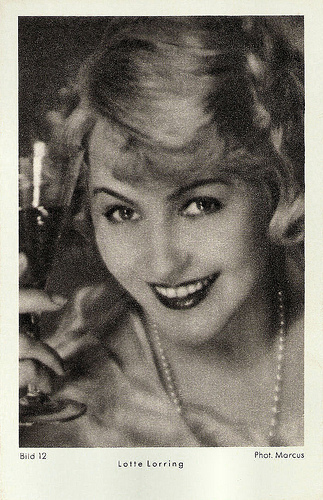
German postcard by Margarinewerk Eidelstedt Gebr. Fauser GmbH, Holstein. Serie 1, Bild 12. Photo: Marcus.
Sources: Thomas Staedeli (Cyranos), Wikipedia (German), and .

Austrian postcard by Iris Verlag, no. 854. Photo: Sascha.
Interesting Directors
Lotte Lorring was born in Berlin, Germany in 1893. First she worked in provincial theatres and she made a name for herself as an operetta singer. In 1919 she made her film debut in Sein letzter Trick/His Last Trick (Rolf Brunner, 1919) with Heinrich Peer and Ernst Pittschau. She then appeared in Der Meisterschuss/The Master Shot (Rolf Brunner, 1920) and Es bleibt in der Familie/It Runs in the Family (Gerhard Lamprecht, 1920), starring Paul Heidemann.
In France, she played in L’ouragan sur la montagne/The Hurricane on the Mountain (Julien Duvivier, 1921) and Le logis de l'horreur/The Sinister Guest (Julien Duvivier, 1921), in which she played the female lead. During the second half of the 1920s, she worked with interesting directors in films like Das graue Haus/The Gray House (Friedrich Feher, 1926) with Magda Sonja, Eine Dubarry von heute/A Modern Dubarry (Alexander Korda, 1926) starring Maria Corda, and Königin Luise.1. Teil: Die jungend der königin Luise/Queen Louise (Karl Grune, 1927).
Lorring co-starred opposite Harry Piel in the comedy Sein größter Bluff/The Big Bluff (Henrik Galeen, Harry Piel, 1927), and opposite Mady Christians in Fräulein Chauffeur/Miss Chauffeur (Jaap Speyer, 1928). In Austria, she appeared for Sascha-Film in Wem gehört meine Frau?/Whom belongs my wife? (Hans Otto, 1929), starring Fritz Kampers.

German postcard by Ross Verlag, no. 4762/1, 1929-1930. Photo: Becker & Maass, Berlin.
Paramount
Lotte Loring played the lead in her first sound film, Karriere/Career (Adolf Trotz, 1930) with Walter Rilla. For Paramount, she played in the German-language comedy Ich heirate meinen Mann/I'm marrying my husband (E.W. Emo, 1931), an alternate-language version of Her Wedding Night (Frank Tuttle, 1930).
In the first years of the sound era, she played in some ten films, but soon her roles became less frequent. She had substantial parts in Schwarzwaldmädel/Black Forest Girl (Georg Zoch,1933), and Johannisnacht/Midsummer Eve (Willy Reiber, 1934) starring Lil Dagover. Her final film was Leichte Kavallerie/Light Cavalry (Werner Hochbaum, 1935), starring Marika Rökk.
Four years later, Lotte Lorring died in her hometown Berlin in 1939. She was only 45.

German postcard by Margarinewerk Eidelstedt Gebr. Fauser GmbH, Holstein. Serie 1, Bild 12. Photo: Marcus.
Sources: Thomas Staedeli (Cyranos), Wikipedia (German), and .
Published on August 17, 2013 23:00
August 16, 2013
Max Hansen
Danish cabaret artist, actor, comedian and singer Max Hansen (1897-1961) was known as 'The Little Caruso'. During the 1920s, he was one of the most popular stars of Berlin.

German postcard by Ross Verlag, no. 5542/1, 1930-1931. Photo: Biograph-Film.
Who Takes Love Seriously?
Max Hansen was born Max Josef Haller in Mannheim, Imperial Germany in 1897. He was an illegitimate child to the Danish actress Eva Haller and the Swedish Officer Schürer von Waldheim (according to other sources he had a Jewish father, the Hungarian artist Joseph Walder). Max grew up with foster-parents in Munich, where he first appeared at the Cabaret Simplizissimus at the age of 17. In 1914 he moved to Vienna, where he completed his studies as a ballad singer. Filmportal.de : “Thinking that it may perhaps be advantageous to draw attention to his Scandinavian origins, he changes his name to Hansen. Profiting from his powerful, highly modulating voice, he becomes known as the ‘little Caruso’ in cabarets and variety theatres, performing comical couplets, sketches and opera parodies.”
In 1923, Hansen was discovered by Hubert Marischka. He asked him for the tenor role of Baron Kolomán Zsupán in the Emmerich Kálmán operetta Gräfin Mariza (Countess Mariza) at the Theater an der Wien in Vienna. After 900 performances, the popular production moved to the Metropoltheater in Berlin, where Hansen became also very successful. In Berlin he founded the KadeKo, the Kabarett der Komiker (the Cabaret of Comedians) with Paul Morgan and Kurt Robitschek in 1924. Hansen was engaged by Max Reinhardt for his revival of Jacques Offenbach's La belle Hélène, and by Erik Charell for his production of Franz Lehar's Die lustige Witwe (The Merry Widow). Hansen's greatest stage success was playing Leopold the waiter in Ralph Benatzky's operetta-musical Im weißen Rößl (The White Horse Inn) in 1930.
He had already undertaken this part in the silent film Im weißen Rößl/The White Horse Inn (Richard Oswald, 1926) with Liane Haid. A year earlier, he had made his film debut in Husarenfieber/Hussars Fever (Georg Jacoby, 1925) with Georg Alexander. In the following years he appeared in popular silent films like Familie Schimeck/The Schimeck Family (Alfred Halm, Rudolf Dworsky,1926), and Venus im Frack/Venus in evening dress (Robert Land, 1927) with Carmen Boni. From 1925 on, Hansen also recorded his own hits, which audiences appreciated for their parody and cabaret-like wit.
His real film career began in the sound film era. His first sound film was Wien, du Stadt der Lieder/Vienna, City of Song (Richard Oswald, 1930) with Charlotte Ander and Paul Morgan. The excellent singer was soon pinned down for swinging musicals and comedies. He found an ideal partner in Jenny Jugo in films like Wer nimmt die Liebe ernst.../Who Takes Love Seriously? (Erich Engel, 1931). He also played opposite Gitta Alpár in Die - oder keine/She, or Nobody (Carl Froelich, 1932).
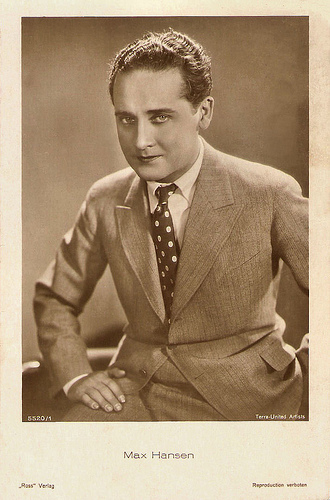
German postcard by Ross Verlag, no. 5520/1, 1930-1931. Photo: Terra / United Artists.
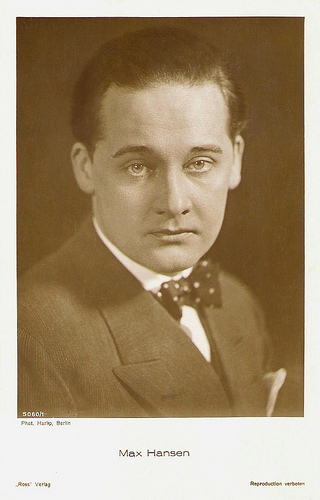
German postcard by Ross Verlag, no. 5060/1, 1930-1931. Photo: Harlip, Berlin.
Have you ever been in love with me?
Max Hansen satirized Adolf Hitler as a homosexual with his song War'n Sie schon mal in mich verliebt? (Have you ever been in love with me?), which caused the rage of the Nazis. He was thrown with tomatoes at the premiere of the comedy Das häßliche Mädchen/The Ugly Girl (Hermann Kosterlitz, 1933). The film was made in early 1933, during the transition from the Weimar Republic to Nazi Germany, and premièred in September that year. According to Wikipedia , the film's representation of the ‘ugly girl’ as outsider has been described as a metaphorical way to explore the outsider existence of Jews. Star Dolly Haas and director Hermann Kosterlitz, both Jewish, left Germany and later worked in the United States, where Kosterlitz became well known as Henry Koster.
Hansen returned to Vienna and worked again at the Theater an der Wien. He starred in the film Csardas (Jacob Fleck, Luise Fleck, Walter Kolm-Veltée, 1935) with Irén Zilahy. He also performed in Switzerland, Amsterdam, Oslo and Helsinki. In 1936 he met Zarah Leander on a Scandinavian tour and engaged her as his stage partner in the operetta Axel an der Himmels Tür (Axel at Heaven’s Gate), with music by Ralph Benatzky, produced in Theater an der Wien. It was a hit. After Austria was invaded by Germany in 1938, Hansen emigrated to Denmark, where he founded his own theatre at Copenhagen. He also appeared in Danish films like Tror du jeg er født i går!/Do you think I was born yesterday! (Lau Lauritzen, Jr., Alice O'Fredericks, 1941) and En flicka för mej (Börje Larsson, 1943). In addition he wrote several songs under the pseudonymous ‘Sylvester’.
In 1951 he returned to Germany and was successful once again singing the role of Leopold the waiter in The White Horse Inn. In 1953 Hansen moved back to Copenhagen, where he died in 1961. His final film appearance was in the Danish comedy Hvad vil De ha'?/What do you want? (Jens Henriksen, Preben Neergaard, 1956) starring Dirch Passer. Hansen was married to Austrian actress Lizzi Waldmüller till 1938 and since 1940 to Britta Annette Sylvester-Hvid. He had four children. His daughter Ann-Mari Max Hansen (1949) and his son Max Hansen Jr. (1954) are both actors too. In 2004 German director Douglas Wolfsperger portrayed Hansen in his documentary War'n Sie schon mal in mich verliebt?
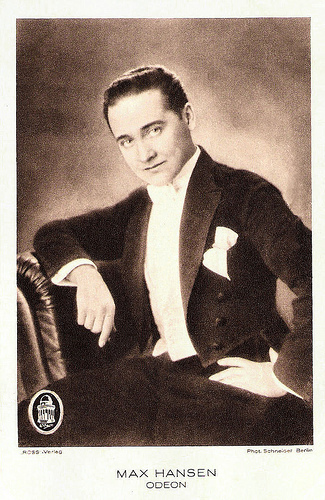
German postcard by Ross Verlag / Odeon. Photo: Schneider, Berlin.
Max Hansen sings War'n Sie schon mal in mich verliebt?. Source: Edmolch (YouTube).
Sources: Thomas Staedeli (Cyranos), Stephanie D’heil (Steffi-line), (IMDb), Filmportal.de, Wikipedia, and .

German postcard by Ross Verlag, no. 5542/1, 1930-1931. Photo: Biograph-Film.
Who Takes Love Seriously?
Max Hansen was born Max Josef Haller in Mannheim, Imperial Germany in 1897. He was an illegitimate child to the Danish actress Eva Haller and the Swedish Officer Schürer von Waldheim (according to other sources he had a Jewish father, the Hungarian artist Joseph Walder). Max grew up with foster-parents in Munich, where he first appeared at the Cabaret Simplizissimus at the age of 17. In 1914 he moved to Vienna, where he completed his studies as a ballad singer. Filmportal.de : “Thinking that it may perhaps be advantageous to draw attention to his Scandinavian origins, he changes his name to Hansen. Profiting from his powerful, highly modulating voice, he becomes known as the ‘little Caruso’ in cabarets and variety theatres, performing comical couplets, sketches and opera parodies.”
In 1923, Hansen was discovered by Hubert Marischka. He asked him for the tenor role of Baron Kolomán Zsupán in the Emmerich Kálmán operetta Gräfin Mariza (Countess Mariza) at the Theater an der Wien in Vienna. After 900 performances, the popular production moved to the Metropoltheater in Berlin, where Hansen became also very successful. In Berlin he founded the KadeKo, the Kabarett der Komiker (the Cabaret of Comedians) with Paul Morgan and Kurt Robitschek in 1924. Hansen was engaged by Max Reinhardt for his revival of Jacques Offenbach's La belle Hélène, and by Erik Charell for his production of Franz Lehar's Die lustige Witwe (The Merry Widow). Hansen's greatest stage success was playing Leopold the waiter in Ralph Benatzky's operetta-musical Im weißen Rößl (The White Horse Inn) in 1930.
He had already undertaken this part in the silent film Im weißen Rößl/The White Horse Inn (Richard Oswald, 1926) with Liane Haid. A year earlier, he had made his film debut in Husarenfieber/Hussars Fever (Georg Jacoby, 1925) with Georg Alexander. In the following years he appeared in popular silent films like Familie Schimeck/The Schimeck Family (Alfred Halm, Rudolf Dworsky,1926), and Venus im Frack/Venus in evening dress (Robert Land, 1927) with Carmen Boni. From 1925 on, Hansen also recorded his own hits, which audiences appreciated for their parody and cabaret-like wit.
His real film career began in the sound film era. His first sound film was Wien, du Stadt der Lieder/Vienna, City of Song (Richard Oswald, 1930) with Charlotte Ander and Paul Morgan. The excellent singer was soon pinned down for swinging musicals and comedies. He found an ideal partner in Jenny Jugo in films like Wer nimmt die Liebe ernst.../Who Takes Love Seriously? (Erich Engel, 1931). He also played opposite Gitta Alpár in Die - oder keine/She, or Nobody (Carl Froelich, 1932).

German postcard by Ross Verlag, no. 5520/1, 1930-1931. Photo: Terra / United Artists.

German postcard by Ross Verlag, no. 5060/1, 1930-1931. Photo: Harlip, Berlin.
Have you ever been in love with me?
Max Hansen satirized Adolf Hitler as a homosexual with his song War'n Sie schon mal in mich verliebt? (Have you ever been in love with me?), which caused the rage of the Nazis. He was thrown with tomatoes at the premiere of the comedy Das häßliche Mädchen/The Ugly Girl (Hermann Kosterlitz, 1933). The film was made in early 1933, during the transition from the Weimar Republic to Nazi Germany, and premièred in September that year. According to Wikipedia , the film's representation of the ‘ugly girl’ as outsider has been described as a metaphorical way to explore the outsider existence of Jews. Star Dolly Haas and director Hermann Kosterlitz, both Jewish, left Germany and later worked in the United States, where Kosterlitz became well known as Henry Koster.
Hansen returned to Vienna and worked again at the Theater an der Wien. He starred in the film Csardas (Jacob Fleck, Luise Fleck, Walter Kolm-Veltée, 1935) with Irén Zilahy. He also performed in Switzerland, Amsterdam, Oslo and Helsinki. In 1936 he met Zarah Leander on a Scandinavian tour and engaged her as his stage partner in the operetta Axel an der Himmels Tür (Axel at Heaven’s Gate), with music by Ralph Benatzky, produced in Theater an der Wien. It was a hit. After Austria was invaded by Germany in 1938, Hansen emigrated to Denmark, where he founded his own theatre at Copenhagen. He also appeared in Danish films like Tror du jeg er født i går!/Do you think I was born yesterday! (Lau Lauritzen, Jr., Alice O'Fredericks, 1941) and En flicka för mej (Börje Larsson, 1943). In addition he wrote several songs under the pseudonymous ‘Sylvester’.
In 1951 he returned to Germany and was successful once again singing the role of Leopold the waiter in The White Horse Inn. In 1953 Hansen moved back to Copenhagen, where he died in 1961. His final film appearance was in the Danish comedy Hvad vil De ha'?/What do you want? (Jens Henriksen, Preben Neergaard, 1956) starring Dirch Passer. Hansen was married to Austrian actress Lizzi Waldmüller till 1938 and since 1940 to Britta Annette Sylvester-Hvid. He had four children. His daughter Ann-Mari Max Hansen (1949) and his son Max Hansen Jr. (1954) are both actors too. In 2004 German director Douglas Wolfsperger portrayed Hansen in his documentary War'n Sie schon mal in mich verliebt?

German postcard by Ross Verlag / Odeon. Photo: Schneider, Berlin.
Max Hansen sings War'n Sie schon mal in mich verliebt?. Source: Edmolch (YouTube).
Sources: Thomas Staedeli (Cyranos), Stephanie D’heil (Steffi-line), (IMDb), Filmportal.de, Wikipedia, and .
Published on August 16, 2013 23:00
August 15, 2013
Mona Goya
Mona Goya (1909–1961) was a Mexican-born French film actress who rose to fame in the 1930s.
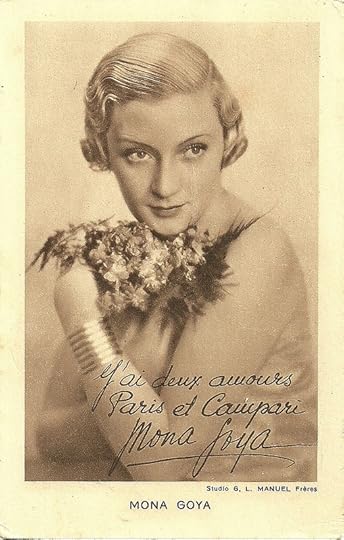
French postcard for Campari. Photo: Studio G.L. Manuel Frères.
Lavish Production
Mona Goya was born Simone Isabelle Marchand in Mexico City in 1909. She probably debuted in film in Germaine Dulac's late silent film Princesse Mandane (1928). In the same year she also acted in various other films, such as the period piece Madame Recamier (1928) by Gaston Ravel and she had a small part in Marcel L'Herbier's lavish production L'Argent (1928), starring Marie Glory, Brigitte Helm and Pierre Alcover.
Goya's career really set off with the arrival of sound film around 1930. She played an upper-class woman who falls in love with a fisherman in the British film The Lady from the Sea (Castleton Knight, 1930) with a young Ray Milland. She also acted opposite Charles Boyer in Revolte en prison (Pál Fejös, George W. Hill, 1930) - the French version of the MGM drama The Big House (George W. Hill, 1930), and in the Georges Biscot comedy Hardi les gars!/Bold guys (Maurice Champreux, 1931).
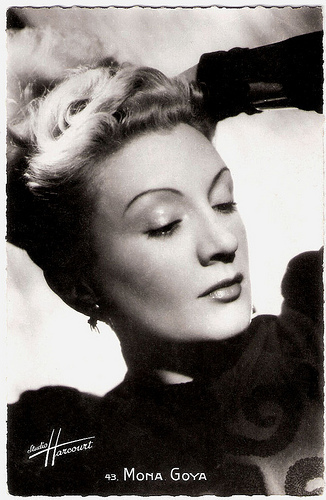
French postcard by S.E.R.P., Paris, no. 43. Photo: Studio Harcourt.
BB
Mona Goya acted opposite Victor Boucher in La Banque Némo (Marguerite Viel, 1934), while in the late 1930s she often acted opposite Fernandel in La porteuse de pain/The Bread Peddler (Renée Sti, 1934), François Ier/Francis the First (Christian-Jaque, 1937), Josette (Christian-Jaque, 1937), and Ernest le rebelle/Ernest the Rebel (Christian-Jaque, 1938).
In the immediate post-war years she was often paired with Bourvil such as in Pas si bête/Not so stupid (André Berthomieu, 1946) and Blanc comme neige/White Like Snow (André Berthomieu, 1948). In the 1950s, she had supporting parts in films with Nicole Courcel (Gibier de potence/Gigolo, (Roger Richebé, 1951); Les amants de Bras-Morts/The Lovers of Bras-Mort (Marcello Pagliero, 1951)) and Brigitte Bardot (Le portrait de son père/His father's portrait (André Berthomieu, 1953); Babette s'en va-t-en guerre/Babette Goes to War (Christian-Jaque, 1959)).
All in all Goya acted in some 80 films, mostly French productions. Between the mid-1940s and late 1950s, she also acted on stage. Mona Goya died of cancer in 1961, at Clichy-la-Garenne. For a while she was married to actor Fernand Fabre, but they divorced.
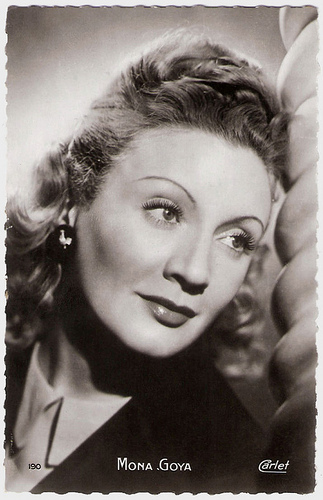
French postcard by Editions P.I., Paris, no. 190. Photo: Carlet.
Sources: Wikipedia (French and English) and .

French postcard for Campari. Photo: Studio G.L. Manuel Frères.
Lavish Production
Mona Goya was born Simone Isabelle Marchand in Mexico City in 1909. She probably debuted in film in Germaine Dulac's late silent film Princesse Mandane (1928). In the same year she also acted in various other films, such as the period piece Madame Recamier (1928) by Gaston Ravel and she had a small part in Marcel L'Herbier's lavish production L'Argent (1928), starring Marie Glory, Brigitte Helm and Pierre Alcover.
Goya's career really set off with the arrival of sound film around 1930. She played an upper-class woman who falls in love with a fisherman in the British film The Lady from the Sea (Castleton Knight, 1930) with a young Ray Milland. She also acted opposite Charles Boyer in Revolte en prison (Pál Fejös, George W. Hill, 1930) - the French version of the MGM drama The Big House (George W. Hill, 1930), and in the Georges Biscot comedy Hardi les gars!/Bold guys (Maurice Champreux, 1931).

French postcard by S.E.R.P., Paris, no. 43. Photo: Studio Harcourt.
BB
Mona Goya acted opposite Victor Boucher in La Banque Némo (Marguerite Viel, 1934), while in the late 1930s she often acted opposite Fernandel in La porteuse de pain/The Bread Peddler (Renée Sti, 1934), François Ier/Francis the First (Christian-Jaque, 1937), Josette (Christian-Jaque, 1937), and Ernest le rebelle/Ernest the Rebel (Christian-Jaque, 1938).
In the immediate post-war years she was often paired with Bourvil such as in Pas si bête/Not so stupid (André Berthomieu, 1946) and Blanc comme neige/White Like Snow (André Berthomieu, 1948). In the 1950s, she had supporting parts in films with Nicole Courcel (Gibier de potence/Gigolo, (Roger Richebé, 1951); Les amants de Bras-Morts/The Lovers of Bras-Mort (Marcello Pagliero, 1951)) and Brigitte Bardot (Le portrait de son père/His father's portrait (André Berthomieu, 1953); Babette s'en va-t-en guerre/Babette Goes to War (Christian-Jaque, 1959)).
All in all Goya acted in some 80 films, mostly French productions. Between the mid-1940s and late 1950s, she also acted on stage. Mona Goya died of cancer in 1961, at Clichy-la-Garenne. For a while she was married to actor Fernand Fabre, but they divorced.

French postcard by Editions P.I., Paris, no. 190. Photo: Carlet.
Sources: Wikipedia (French and English) and .
Published on August 15, 2013 23:00
August 14, 2013
Joë Hamman
We generally associate the Western with the American cinema, but in the early years of the cinema there were European Westerns too. The French Western was often filmed in the Camargue, in the South of France, and Joë Hamman (1883-1974) was the French equivalent of the film cowboy. Joë had a long ranging career from 1907 to 1967, and besides his acting career he was also an affluent film director.
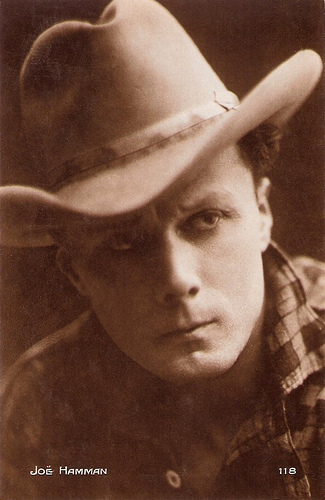
French postcard, Editions Cinémagazine. no. 118.
Buffalo Bill
Joë Hamman aka Joe Hamman (not to be confused with American cinematographer-producer Joe Hamann) was born as Jean Hamman in Paris, France, in 1883. His father was a Dutch expert in painting, his mother a former lady’s companion of Empress Eugénie. Hamman studied in Paris and London before going to art school in Paris. He became a noted water colourist, but he chose a different career.
When Jean was six, the circus of Buffalo Bill alias William Cody came to Paris, but young Hamman was not allowed to go. He had to wait until he was 21 and meet Cody, when his father took him on a business trip to America in 1904. Hamman and Cody met privately, became friends, and Hamman visited Cody’s North Plate house in Nebraska, meeting the extras of Cody’s wild west show, and drawing watercolours for local rangers. At a ranch in Montana, Jean Hamman learned to ride, was engaged as a cowboy, and learned to break and gather horses.
He also visited the Pine Ridge reservation in Dakota, and met Spotted Tail, war lieutenant of Indian chief Red Cloud, who donated him a buckskin war costume. Autumn 1904, he returned to Paris to do his military service, during which he staged a coach attack. When in 1905 Cody’s circus came over, Hamman was invited to join and participated in the French tour of Buffalo Bill. And Jean became Joë Hamman.
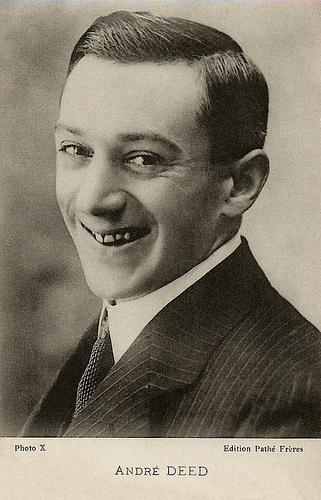
André Deed. French postcard by Edition Pathé Frères. Photo: X.
Le Desperado
In 1907 Joë Hamman started out in the cinema as both actor and director of the short silent Le desperado/The Desperado (Joë Hamman, 1907). He followed his debut with performances in some 40 more short Westerns until early 1914. These shorts included Un drame mexicain/A Mexican Drama (Joë Hamman, 1909), Un drame au Far West/A Far West Drama (Joë Hamman, 1909), and Les aventures de Buffalo Bill/The Adventures of Buffalo Bill (Joë Hamman, 1911).
For studio Éclair he starred in the tree-part serial Le vautour de la Sierra/The Vulture of the Sierra (Victorine-Hipolyte Jasset, 1909), but most of the short Westerns with Hamman were produced by Gaumont. A successful example was Le railway de la mort/The Railway of Death (Jean Durand, 1912) with Gaston Modot. From 1910 on, director Jean Durand specialised in the genre at Gaumont, though director Léonce Perret also shot some of the Gaumont Westerns.
Gaston Modot is nowadays best known as a comedian, but he was often Hamman’s antagonist in the Gaumont Westerns. Hamman directed 10 early shorts himself. He also worked for the Eclipse company in different genres, such as the adventure film L’ile d’épouvante/The Island of Terror (1911) and the Western La ville souterraine/The Subterranean City (1913).
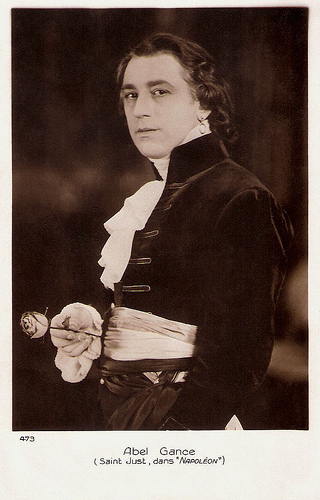
Abel Gance. French postcard by Cinémagazine-Edition, no. 473. Photo: publicity still for Napoléon (Abel Gance, 1927), with Gance himself as Saint Just.
Famous Epic
During the First World War, Joë Hamman's film acting and directing came to a halt. In 1921 he returned as an actor-director with the short adventure film Le gardian/The Rancher (Joë Hamman, 1921). In Tao ( Gaston Ravel, 1923) he appeared with other pre-war actors such as comedian André Deed. He had the male lead as Chevalier de Mallory in the costume drama L’enfant roi/The Child King (Jean Kemm, 1923), opposite Andrée Lionel as queen Marie Antoinette.
The next year followed supporting parts in Le vert galant/The Don Juan (René Leprince, 1924), Les fils du soleil/The Sons of the Sun (René le Somptier, 1924), and the detective film Le stigmate/The Stigma (Louis Feuillade, Maurice Champreux, 1924) with Jean Murat.
After a break in 1925 followed six films in 1926: Sa petite/His Little Girl (Routier-Fabre, 1926), Le capitaine Frascasse/Captain Fracasse (Henri Desfontaines, 1926), La fille des pachas/The Daughter of the Pacha (Joë Hamman, Adrien Caillard, 1926), Lady Harrington (Hewitt Claypoole Grantham-Hayes, Fred LeRoy Granville, 1926), and Le berceau de Dieu/The Cradle of God (Fred LeRoy Granville, 1926). The latter was a religious drama starring Léon Mathot in which Hamman played a triple role of Abner, Pharao and Confucius. After Sous le ciel d’Orient (Fred LeRoy Granville, 1927), opposite his old buddy Gaston Modot, Hamman ended his silent film career with a bit part as Baskytt in Abel Gance's famous epic Napoléon (1927).
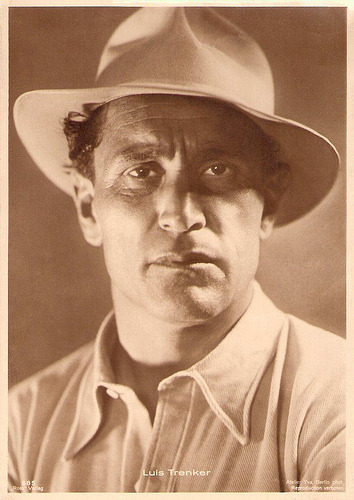
Luis Trenker. German postcard by Ross Verlag, no. 685, 1919-1924. Photo: Atelier Yva, Berlin.
For the Last Time
When sound cinema arrived, Joë Hamman made a comeback and played leads in several early sound films. He was the title character in Le roi des aulnes/The Erl King (Marie-Louise Iribe, 1930-1931) based on Johan Wolfgang Goethe’s ballad. He appeared in both the German version, Erlkönig, and the French version, Le roi des aulnes. Hamman also featured in Adieu les copains/Farewell Mates (Léo Joannon, 1930), and he appeared and co-directed the French version of Luis Trenker’s Berge in Flamme: Les monts en flammes/Mountain in Flames (Joë Hamman, Luis Trenker, 1931).
His parts got smaller, such as in Je serai seule après minuit/After Midnight I'm Alone (Jacques de Baroncelli, 1931), Romance à l’inconnue/Romance With An Unknown Woman (René Barberis, 1931) starring Annabella, Danton (André Roubaud, 1932), the Mistral-adaptation Mireille (René Gaveau, 1933), Le train d’amour/The Love Train (Pierre Weil, 1935), and Le clown Bux/Bux, the Clown (Jacques Natanson, 1935) starring Suzy Vernon, in which Hamman played a cowboy for the last time.
In the late 1930s, Hamman played smaller parts in four films by Henri Fescourt: L’occident/The West (1937), Bar du sud/Southern Bar (1938), Vous seule que j’aime/I Love You Alone (1939), and Face au destin/Facing Destiny (1940) with Jules Berry. The latter film proved to be emblematically titled. France had just got involved in the Second World War and Hamman himself faced destiny too: during the war he was not offered anymore film roles. And after the war, Hamman played an uncredited role as general Kellermann in Napoléon (Sacha Guitry, 1955), starring Jean-Pierre Aumont. His only other and final performance was an uncredited part in Pop’game (Francis Leroi, 1967). Joë Hamman died in Dieppe, France, in 1974. Some of his early Westerns are now on DVD. Gaumont, Le cinéma premier, II (2009) contains one disc with Jean Durand's Westerns shot in the Camargue.
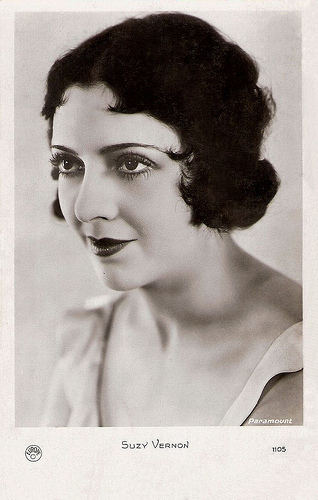
Suzy Vernon. French postcard by Europe, no. 1105. Photo: Paramount.
Sources: Herve Ciret (An Indian in the Western Lighthouse), Wikipedia (French) and .

French postcard, Editions Cinémagazine. no. 118.
Buffalo Bill
Joë Hamman aka Joe Hamman (not to be confused with American cinematographer-producer Joe Hamann) was born as Jean Hamman in Paris, France, in 1883. His father was a Dutch expert in painting, his mother a former lady’s companion of Empress Eugénie. Hamman studied in Paris and London before going to art school in Paris. He became a noted water colourist, but he chose a different career.
When Jean was six, the circus of Buffalo Bill alias William Cody came to Paris, but young Hamman was not allowed to go. He had to wait until he was 21 and meet Cody, when his father took him on a business trip to America in 1904. Hamman and Cody met privately, became friends, and Hamman visited Cody’s North Plate house in Nebraska, meeting the extras of Cody’s wild west show, and drawing watercolours for local rangers. At a ranch in Montana, Jean Hamman learned to ride, was engaged as a cowboy, and learned to break and gather horses.
He also visited the Pine Ridge reservation in Dakota, and met Spotted Tail, war lieutenant of Indian chief Red Cloud, who donated him a buckskin war costume. Autumn 1904, he returned to Paris to do his military service, during which he staged a coach attack. When in 1905 Cody’s circus came over, Hamman was invited to join and participated in the French tour of Buffalo Bill. And Jean became Joë Hamman.

André Deed. French postcard by Edition Pathé Frères. Photo: X.
Le Desperado
In 1907 Joë Hamman started out in the cinema as both actor and director of the short silent Le desperado/The Desperado (Joë Hamman, 1907). He followed his debut with performances in some 40 more short Westerns until early 1914. These shorts included Un drame mexicain/A Mexican Drama (Joë Hamman, 1909), Un drame au Far West/A Far West Drama (Joë Hamman, 1909), and Les aventures de Buffalo Bill/The Adventures of Buffalo Bill (Joë Hamman, 1911).
For studio Éclair he starred in the tree-part serial Le vautour de la Sierra/The Vulture of the Sierra (Victorine-Hipolyte Jasset, 1909), but most of the short Westerns with Hamman were produced by Gaumont. A successful example was Le railway de la mort/The Railway of Death (Jean Durand, 1912) with Gaston Modot. From 1910 on, director Jean Durand specialised in the genre at Gaumont, though director Léonce Perret also shot some of the Gaumont Westerns.
Gaston Modot is nowadays best known as a comedian, but he was often Hamman’s antagonist in the Gaumont Westerns. Hamman directed 10 early shorts himself. He also worked for the Eclipse company in different genres, such as the adventure film L’ile d’épouvante/The Island of Terror (1911) and the Western La ville souterraine/The Subterranean City (1913).

Abel Gance. French postcard by Cinémagazine-Edition, no. 473. Photo: publicity still for Napoléon (Abel Gance, 1927), with Gance himself as Saint Just.
Famous Epic
During the First World War, Joë Hamman's film acting and directing came to a halt. In 1921 he returned as an actor-director with the short adventure film Le gardian/The Rancher (Joë Hamman, 1921). In Tao ( Gaston Ravel, 1923) he appeared with other pre-war actors such as comedian André Deed. He had the male lead as Chevalier de Mallory in the costume drama L’enfant roi/The Child King (Jean Kemm, 1923), opposite Andrée Lionel as queen Marie Antoinette.
The next year followed supporting parts in Le vert galant/The Don Juan (René Leprince, 1924), Les fils du soleil/The Sons of the Sun (René le Somptier, 1924), and the detective film Le stigmate/The Stigma (Louis Feuillade, Maurice Champreux, 1924) with Jean Murat.
After a break in 1925 followed six films in 1926: Sa petite/His Little Girl (Routier-Fabre, 1926), Le capitaine Frascasse/Captain Fracasse (Henri Desfontaines, 1926), La fille des pachas/The Daughter of the Pacha (Joë Hamman, Adrien Caillard, 1926), Lady Harrington (Hewitt Claypoole Grantham-Hayes, Fred LeRoy Granville, 1926), and Le berceau de Dieu/The Cradle of God (Fred LeRoy Granville, 1926). The latter was a religious drama starring Léon Mathot in which Hamman played a triple role of Abner, Pharao and Confucius. After Sous le ciel d’Orient (Fred LeRoy Granville, 1927), opposite his old buddy Gaston Modot, Hamman ended his silent film career with a bit part as Baskytt in Abel Gance's famous epic Napoléon (1927).

Luis Trenker. German postcard by Ross Verlag, no. 685, 1919-1924. Photo: Atelier Yva, Berlin.
For the Last Time
When sound cinema arrived, Joë Hamman made a comeback and played leads in several early sound films. He was the title character in Le roi des aulnes/The Erl King (Marie-Louise Iribe, 1930-1931) based on Johan Wolfgang Goethe’s ballad. He appeared in both the German version, Erlkönig, and the French version, Le roi des aulnes. Hamman also featured in Adieu les copains/Farewell Mates (Léo Joannon, 1930), and he appeared and co-directed the French version of Luis Trenker’s Berge in Flamme: Les monts en flammes/Mountain in Flames (Joë Hamman, Luis Trenker, 1931).
His parts got smaller, such as in Je serai seule après minuit/After Midnight I'm Alone (Jacques de Baroncelli, 1931), Romance à l’inconnue/Romance With An Unknown Woman (René Barberis, 1931) starring Annabella, Danton (André Roubaud, 1932), the Mistral-adaptation Mireille (René Gaveau, 1933), Le train d’amour/The Love Train (Pierre Weil, 1935), and Le clown Bux/Bux, the Clown (Jacques Natanson, 1935) starring Suzy Vernon, in which Hamman played a cowboy for the last time.
In the late 1930s, Hamman played smaller parts in four films by Henri Fescourt: L’occident/The West (1937), Bar du sud/Southern Bar (1938), Vous seule que j’aime/I Love You Alone (1939), and Face au destin/Facing Destiny (1940) with Jules Berry. The latter film proved to be emblematically titled. France had just got involved in the Second World War and Hamman himself faced destiny too: during the war he was not offered anymore film roles. And after the war, Hamman played an uncredited role as general Kellermann in Napoléon (Sacha Guitry, 1955), starring Jean-Pierre Aumont. His only other and final performance was an uncredited part in Pop’game (Francis Leroi, 1967). Joë Hamman died in Dieppe, France, in 1974. Some of his early Westerns are now on DVD. Gaumont, Le cinéma premier, II (2009) contains one disc with Jean Durand's Westerns shot in the Camargue.

Suzy Vernon. French postcard by Europe, no. 1105. Photo: Paramount.
Sources: Herve Ciret (An Indian in the Western Lighthouse), Wikipedia (French) and .
Published on August 14, 2013 23:00
August 13, 2013
Anthony Steffen
Elegant, educated and handsome Anthony Steffen (Antonio Luiz De Teffè, 1929-2004) appeared in over 60 films, many of them in the lead role. The Italian-Brazilian actor had a cult following thanks to his roles in 27 Spaghetti Westerns between 1965 and 1975.
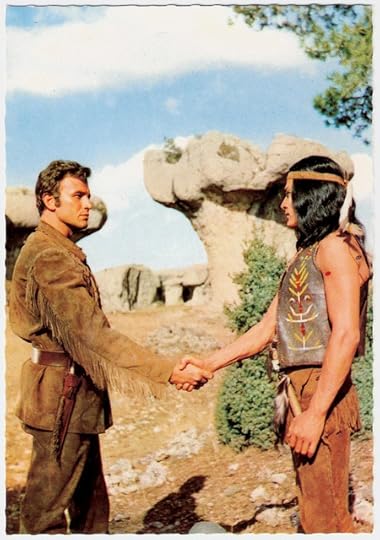
German postcard, no. 4 of 64. Photo: Constantin. Still from Der Lezte Mohikaner/The Last Tomahawk (1965) with Daniel Martin (right).
Sword and Sandal Epics
Anthony Steffen was born as Antonio Luiz De Teffè von Hoonholtz in 1929, at the Brazilian embassy in Rome. He was the son of Formula 1 champion and Brazilian ambassador Manoel de Teffè. During World War II, teenager Antonio left home to join the partisans against the Nazis. After the war he worked as a messenger boy on Ladri di biciclette/Bicycle Thieves (Vittorio De Sica, 1948) and as a second assistant director on Ci troviamo in galleria/We are in the gallery (Mauro Bolognini, 1953). He started acting in secondary roles in small scale dramas like Gli Sbandati/Abandoned (Francesco Maselli, 1955) starring Lucia Bosé, and Beatrice Cenci/Castle of the Banned Lovers (Riccardo Freda, 1956) with Micheline Presle. In these films he was credited as Antonio de Teffè. He also found gainful employment in the Peplum films, the sword and sandal epics, such as Afrodite, dea dell'amore/Aphrodite, Goddess of Love (Mario Bonnard, 1958) with Isabelle Corey, and played a small role in Sodom and Gomorrah (Robert Aldrich, 1962) starring Stewart Granger.
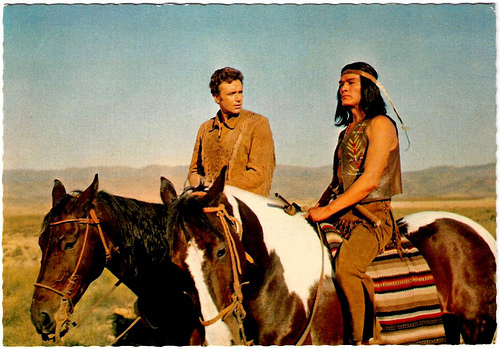
German postcard, no. 1 of 64. Photo: Constantin. Still from Der Letze Mohikaner (1965).
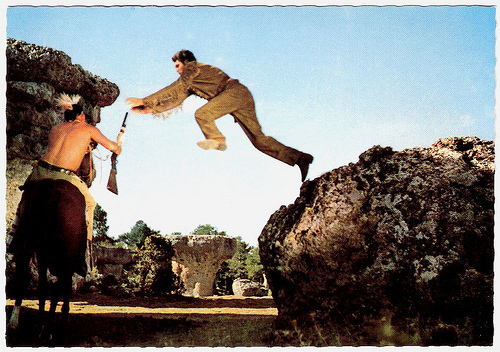
German postcard, no. 3. Photo: Constantin. Still from Der Lezte Mohikaner (1965).
Hawkeye
Under the name Anthony Steffen, he carved a reputation within the Spaghetti Western genre between 1965 and 1975. He featured in such films as Uno Straniero a Paso Bravo/A Stranger in Paso Bravo (Salvatore Rosso, 1968), which created a cult following amongst European Exploitation fans. In the Euro-western Der Letze Mohikaner/The Last Tomahawk (Harald Reinl, 1965), he played the frontiersman Natty Bumppo, also known as Falkenauge (Hawkeye). He is the white ally of Unkas (Daniel Martin), the son of the chief of the Mohicans. They discover that the Huron and a gang of white bandits have destroyed the tribe of the Mohicans, and take revenge. The film was based on the famous novel The Last of the Mohicans by James Fenimore Cooper.
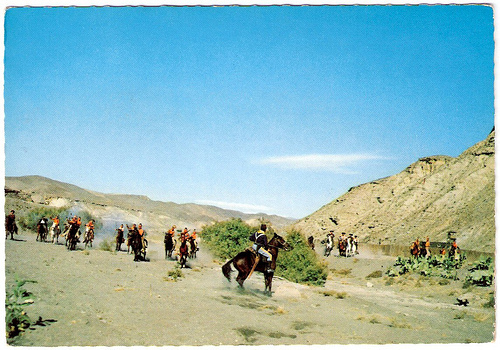
German postcard, no. 12 of 64. Photo: Constantin. Still from Der Lezte Mohikaner.
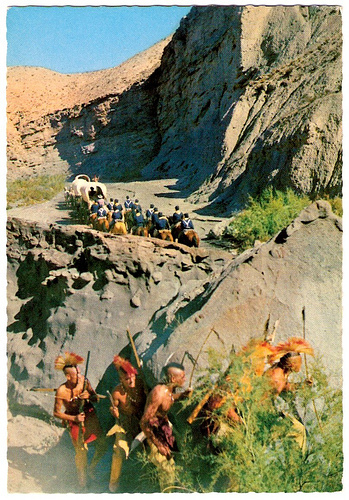
German postcard, no. 17 of 64. Photo: Constantin. Still from Der Lezte Mohikaner.
Steely-faced Gunslinger
According to Matt Blake at European Film Review , Anthony Steffen is often (and unfairly) being detracted as a ‘wooden’ performer, but in many ways he is ideally suited to playing the steely-faced gunslinger synonymous with the Spaghetti Western. Steffen's most memorable role was Django in Pochi dollari per Django/Few Dollars for Django (Léon G. Klimovsky and – uncredited – Enzo G. Castellari, 1966) opposite another icon of the Spaghetti Western, Frank Wolff, and Django il bastardo/Django The Bastard (Sergio Garrone, 1969). In the latter, which he also co-wrote and produced, he played a phantom gunslinger returned from the grave to avenge his own death. According to Wikipedia , it is considered to be an inspiration for Clint Eastwood's High Plains Drifter (1973). Outside of the Spaghetti Western genre, Steffen also appeared in several Giallo films including La notte che Evelyn uscì dalla tomba/The Night Evelyn Came Out of the Grave (Emilio Miraglia, 1971). As with many of his contemporaries, the number of Steffen's roles diminished as the 1970s progressed and the Spaghetti Western genre fell into decline. One of his last films was the Brazilian thriller Momentos de Prazer e Agonia/Moments of pleasure and agony (Adnor Pitanga, 1983). Anthony Steffen eventually retired to Brazil and died in Rio de Janeiro in 2004 of cancer. He was 73 and left two sons from his marriage in Rome, Manuel and Luiz.
Anthony Steffen vs William Berger in Una lunga fila di croci/No Room To Die (Sergio Garrone, 1969). Source: Pasolini85 (YouTube).
Opening Scene of Django il bastardo/Django The Bastard (Sergio Garrone, 1969). Source: Pecosbr (YouTube).
Sources: Matt Blake (European Film Review), (IMDb), and Wikipedia.

German postcard, no. 4 of 64. Photo: Constantin. Still from Der Lezte Mohikaner/The Last Tomahawk (1965) with Daniel Martin (right).
Sword and Sandal Epics
Anthony Steffen was born as Antonio Luiz De Teffè von Hoonholtz in 1929, at the Brazilian embassy in Rome. He was the son of Formula 1 champion and Brazilian ambassador Manoel de Teffè. During World War II, teenager Antonio left home to join the partisans against the Nazis. After the war he worked as a messenger boy on Ladri di biciclette/Bicycle Thieves (Vittorio De Sica, 1948) and as a second assistant director on Ci troviamo in galleria/We are in the gallery (Mauro Bolognini, 1953). He started acting in secondary roles in small scale dramas like Gli Sbandati/Abandoned (Francesco Maselli, 1955) starring Lucia Bosé, and Beatrice Cenci/Castle of the Banned Lovers (Riccardo Freda, 1956) with Micheline Presle. In these films he was credited as Antonio de Teffè. He also found gainful employment in the Peplum films, the sword and sandal epics, such as Afrodite, dea dell'amore/Aphrodite, Goddess of Love (Mario Bonnard, 1958) with Isabelle Corey, and played a small role in Sodom and Gomorrah (Robert Aldrich, 1962) starring Stewart Granger.

German postcard, no. 1 of 64. Photo: Constantin. Still from Der Letze Mohikaner (1965).

German postcard, no. 3. Photo: Constantin. Still from Der Lezte Mohikaner (1965).
Hawkeye
Under the name Anthony Steffen, he carved a reputation within the Spaghetti Western genre between 1965 and 1975. He featured in such films as Uno Straniero a Paso Bravo/A Stranger in Paso Bravo (Salvatore Rosso, 1968), which created a cult following amongst European Exploitation fans. In the Euro-western Der Letze Mohikaner/The Last Tomahawk (Harald Reinl, 1965), he played the frontiersman Natty Bumppo, also known as Falkenauge (Hawkeye). He is the white ally of Unkas (Daniel Martin), the son of the chief of the Mohicans. They discover that the Huron and a gang of white bandits have destroyed the tribe of the Mohicans, and take revenge. The film was based on the famous novel The Last of the Mohicans by James Fenimore Cooper.

German postcard, no. 12 of 64. Photo: Constantin. Still from Der Lezte Mohikaner.

German postcard, no. 17 of 64. Photo: Constantin. Still from Der Lezte Mohikaner.
Steely-faced Gunslinger
According to Matt Blake at European Film Review , Anthony Steffen is often (and unfairly) being detracted as a ‘wooden’ performer, but in many ways he is ideally suited to playing the steely-faced gunslinger synonymous with the Spaghetti Western. Steffen's most memorable role was Django in Pochi dollari per Django/Few Dollars for Django (Léon G. Klimovsky and – uncredited – Enzo G. Castellari, 1966) opposite another icon of the Spaghetti Western, Frank Wolff, and Django il bastardo/Django The Bastard (Sergio Garrone, 1969). In the latter, which he also co-wrote and produced, he played a phantom gunslinger returned from the grave to avenge his own death. According to Wikipedia , it is considered to be an inspiration for Clint Eastwood's High Plains Drifter (1973). Outside of the Spaghetti Western genre, Steffen also appeared in several Giallo films including La notte che Evelyn uscì dalla tomba/The Night Evelyn Came Out of the Grave (Emilio Miraglia, 1971). As with many of his contemporaries, the number of Steffen's roles diminished as the 1970s progressed and the Spaghetti Western genre fell into decline. One of his last films was the Brazilian thriller Momentos de Prazer e Agonia/Moments of pleasure and agony (Adnor Pitanga, 1983). Anthony Steffen eventually retired to Brazil and died in Rio de Janeiro in 2004 of cancer. He was 73 and left two sons from his marriage in Rome, Manuel and Luiz.
Anthony Steffen vs William Berger in Una lunga fila di croci/No Room To Die (Sergio Garrone, 1969). Source: Pasolini85 (YouTube).
Opening Scene of Django il bastardo/Django The Bastard (Sergio Garrone, 1969). Source: Pecosbr (YouTube).
Sources: Matt Blake (European Film Review), (IMDb), and Wikipedia.
Published on August 13, 2013 23:00
August 12, 2013
Marie Glory
Coquettish and captivating Marie Glory (1905-2009) made more than 50 films during the course of nearly four decades, from 1924 to 1960. For a long time, she was the longest living star of the silent era, but in 2009 she died at the age of 103.
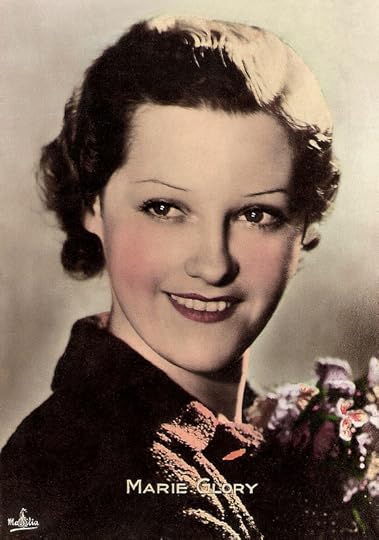
French card by Massilia.
Jazz Bank
Marie Glory was born Raymonde Louise Marcelly Toully in Mortagne-au-Perche, Normandy, in 1905. Her father was a hairdresser, her mother a painter. When she was still an infant, the family moved to Rouen, where she studied at the Lycée Jeanne d'Arc. Aged 18, and chaperoned by her mother, she moved to Paris, where she enrolled in dance classes. It was in the French capital that she entered the first of many beauty contests, winning second place and her first professional job, working as an advertiser's model posing for postcards and posters.
She made her film debut in 1924 with a small role in Le Miracle des Loups/The Miracle of the Wolves (Raymond Bernard, 1924), a historical adventure set in the court of Louis XI. In this film she appeared under the stage name Arlette Genny, which she used until 1927, but she had her real breakthrough under the name Marie Glory in the late silent film classic L'Argent/Jazz Bank (Marcel L'Herbier, 1928) opposite Brigitte Helm. Glory played Line, the wife of aviator Hamelin (Henry Victor) who is manipulated by business tycoon Saccard (Pierre Alcover) to fly to Guyana and drill for oil there. Saccard tries to seduce Line while Hamelin is away, but she sees through his scheming and accuses him of fraud. The three hours plus French-German co-production was based on Emile Zola's classical homonymous novel but temporally transposed to the 1920s instead of the 1860s.
With her porcelain features and cloud of hair, Glory went on to captivate audiences in a string of silent films. She starred with Jean Angelo, Lil Dagover and Gaston Modot in the Franco-German coproduction Monte Cristo/The Count of Monte Christo (Henri Fescourt, 1929) and in the German production Vater und Sohn/Father and Son (Geza von Bolvary, 1929) opposite Harry Liedtke. Glory's first sound film was Le Roi de Paris/The King of Paris (1930, Leo Mittler), with exiled Serbian matinee idol Iván Petrovich.
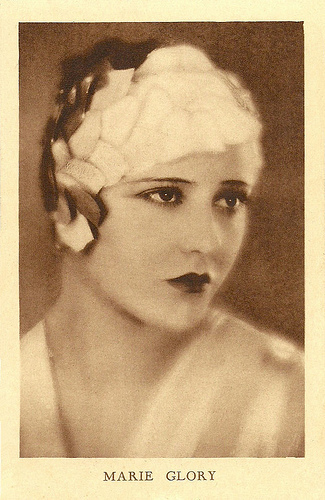
French card. Collection: Didier Hanson.
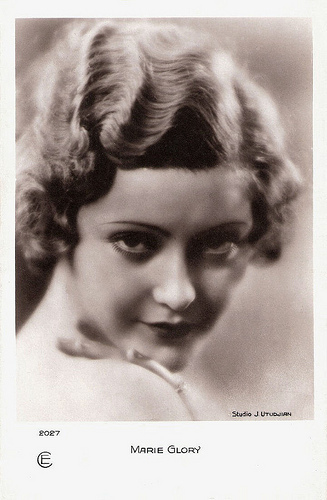
French postcard by Editions Cinémagazine, no. 2027. Photo: Studio J. Utudjian.
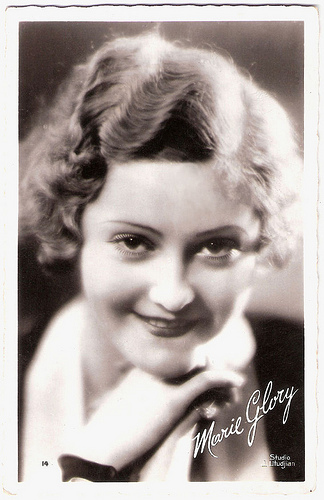
French postcard by Editions et Publications cinématographiques, no. 14. Photo: Studio J. Utudjian.
The Last Refuge
In the 1930s, Marie Glory played many leading roles in films like the war drama Les deux mondes/Two Worlds (Ewald André Dupont, 1930) with Henri Garat, Dactylo (Wilhelm Thiele, 1931) with Jean Murat, Madame ne veut pas d'enfants/No Children Wanted (Hanns Steinhoff, Constantin Landau, 1933), Le paquebot Tenacity/S.S. Tenacity (Julien Duvivier, 1934) opposite Albert Préjean, and the comedy Les amants terribles/The Terrible Lovers (Marc Allégret, 1936), an adaptation of Noël Coward's Private Lives. In the circus drama Les gens du voyage/People Who Travel (Jacques Feyder, 1938), she co-starred with Françoise Rosay.
While already acquainted with Italian directors when working in France, from the late 1930s on, Glory played in several Italian films: Napoli che non muore/Naples That Never Dies (Amleto Palermi, 1939) with Fosco Giacchetti, Terra di fuoco/Land of Fire (Giorgio Ferroni, Marcel L'Herbier, 1939) with the great lyric tenor Tito Schipa, and Una moglie in pericolo/A Wife in Danger (Max Neufeld, 1939), which would turn out to be her last leading film part. When war broke out in 1939, she was shooting The Last Refuge, written by the screenwriter Jacques Constant, whom she later married. She was advised to leave Nazi occupied Paris, and the film was abandoned and never finished.
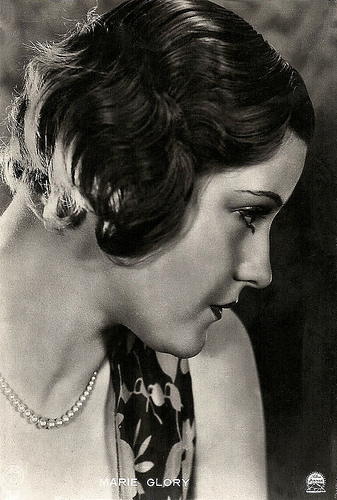
French postcard. Photo: Paramount.
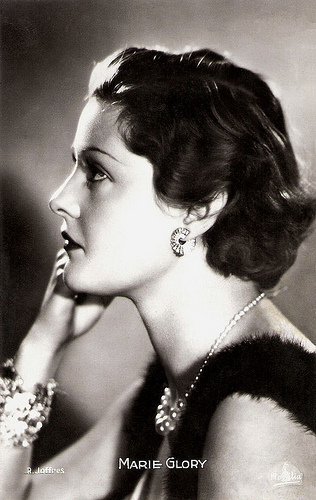
French card by Massilia. Photo: R. Joffres.
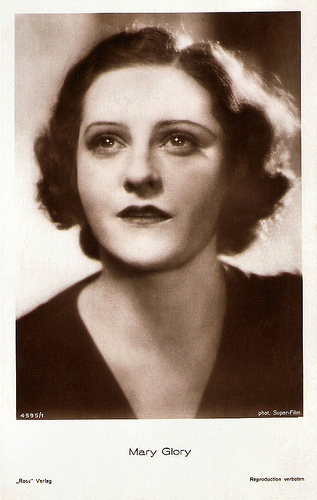
German postcard by Ross Verlag, no. 4595/1, 1929-1930. Photo: Super-Film.
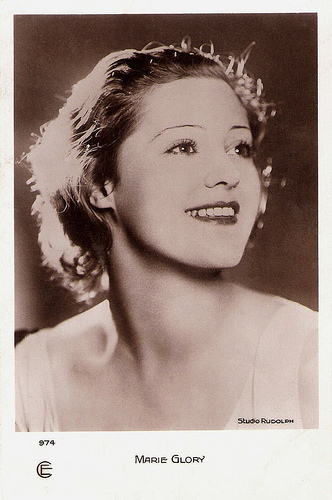
French postcard by Editions et Publications cinématographiques, no. 974. Photo: Studio Rudolph.
Cinema Europe
Two years later, Marie Glory escaped with Constant to Spain via Biarritz, and then over the Portuguese border. She crossed the Atlantic to Buenos Aires and became active in relief and charitable work on behalf of children in occupied France. In 1942 she moved to Algeria and then Martinique, where she worked in propaganda radio. She was one of the few actresses to work under the aegis of the Free French Forces of General de Gaulle.
Following the armistice, Glory returned to France. She was decorated by the Allies, but was unable to regain her former status in the French film industry. In the 1950s she was seen in minor roles in French and Italian films. She played Antonella Lualdi‘s mother in Adorables créatures/Adorable Creatures (Christian-Jaque, 1952), Brigitte Bardot‘s mother-in-law in Et Dieu… créa la femme/…And God Created Woman (Roger Vadim, 1955), and a café customer in Pierre Chenal‘s Raffles sur la ville/Sinners of Paris (1958) with Charles Vanel.
She stopped as a film actress in 1960 and as a television actress in 1964. In 1967 she returned to Paris, where she opened and managed her own beauty salon. She retired in 1973 and settled in Cannes in the south of France. Glory was one of the actresses interviewed by Kevin Brownlow for his memorable TV-series on the silent European cinema: Cinema Europe: The Other Hollywood (1996). In 2006, she was a guest of honour at the Cannes Film Festival‘s special screening of the restored Monte Cristo. In 2009, Marie Glory passed away in her house in Cannes, two months shy of her 104th birthday.
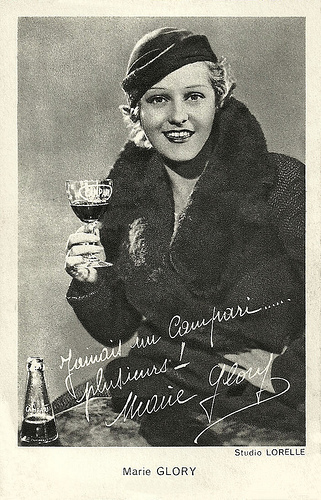
French postcard for Campari. Photo: Studio Lorelle. Caption: "J'aimais un Campari... plusieurs!"
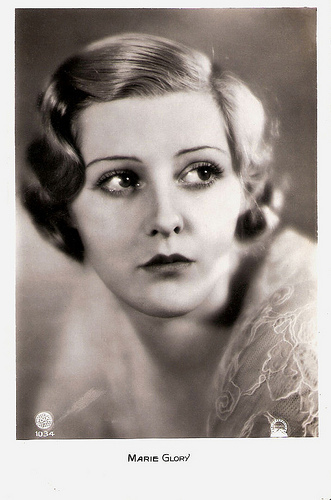
French postcard by E.D.U.G., no. 1034. Photo: Paramount.
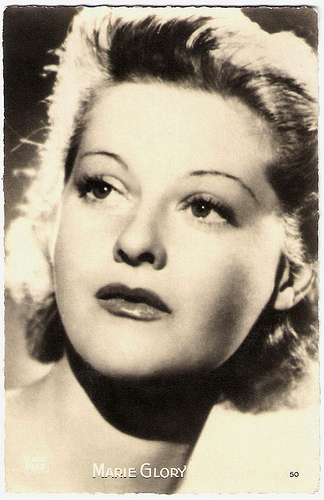
French postcard by O.P., Paris, no. 50. Photo: Studio Piaz.
A fan's tribute to Marie Glory. Song: Marie (1929) by Rudy Vallee And His Connecticut Yankees. Source: Aaron1912 (YouTube).
Sources: Andre Soares (Alt Film Guide), Yvan Foucart (Les Gens du Cinema) (French), Telegraph, The Times, The Bioscope, Wikipedia and .

French card by Massilia.
Jazz Bank
Marie Glory was born Raymonde Louise Marcelly Toully in Mortagne-au-Perche, Normandy, in 1905. Her father was a hairdresser, her mother a painter. When she was still an infant, the family moved to Rouen, where she studied at the Lycée Jeanne d'Arc. Aged 18, and chaperoned by her mother, she moved to Paris, where she enrolled in dance classes. It was in the French capital that she entered the first of many beauty contests, winning second place and her first professional job, working as an advertiser's model posing for postcards and posters.
She made her film debut in 1924 with a small role in Le Miracle des Loups/The Miracle of the Wolves (Raymond Bernard, 1924), a historical adventure set in the court of Louis XI. In this film she appeared under the stage name Arlette Genny, which she used until 1927, but she had her real breakthrough under the name Marie Glory in the late silent film classic L'Argent/Jazz Bank (Marcel L'Herbier, 1928) opposite Brigitte Helm. Glory played Line, the wife of aviator Hamelin (Henry Victor) who is manipulated by business tycoon Saccard (Pierre Alcover) to fly to Guyana and drill for oil there. Saccard tries to seduce Line while Hamelin is away, but she sees through his scheming and accuses him of fraud. The three hours plus French-German co-production was based on Emile Zola's classical homonymous novel but temporally transposed to the 1920s instead of the 1860s.
With her porcelain features and cloud of hair, Glory went on to captivate audiences in a string of silent films. She starred with Jean Angelo, Lil Dagover and Gaston Modot in the Franco-German coproduction Monte Cristo/The Count of Monte Christo (Henri Fescourt, 1929) and in the German production Vater und Sohn/Father and Son (Geza von Bolvary, 1929) opposite Harry Liedtke. Glory's first sound film was Le Roi de Paris/The King of Paris (1930, Leo Mittler), with exiled Serbian matinee idol Iván Petrovich.

French card. Collection: Didier Hanson.

French postcard by Editions Cinémagazine, no. 2027. Photo: Studio J. Utudjian.

French postcard by Editions et Publications cinématographiques, no. 14. Photo: Studio J. Utudjian.
The Last Refuge
In the 1930s, Marie Glory played many leading roles in films like the war drama Les deux mondes/Two Worlds (Ewald André Dupont, 1930) with Henri Garat, Dactylo (Wilhelm Thiele, 1931) with Jean Murat, Madame ne veut pas d'enfants/No Children Wanted (Hanns Steinhoff, Constantin Landau, 1933), Le paquebot Tenacity/S.S. Tenacity (Julien Duvivier, 1934) opposite Albert Préjean, and the comedy Les amants terribles/The Terrible Lovers (Marc Allégret, 1936), an adaptation of Noël Coward's Private Lives. In the circus drama Les gens du voyage/People Who Travel (Jacques Feyder, 1938), she co-starred with Françoise Rosay.
While already acquainted with Italian directors when working in France, from the late 1930s on, Glory played in several Italian films: Napoli che non muore/Naples That Never Dies (Amleto Palermi, 1939) with Fosco Giacchetti, Terra di fuoco/Land of Fire (Giorgio Ferroni, Marcel L'Herbier, 1939) with the great lyric tenor Tito Schipa, and Una moglie in pericolo/A Wife in Danger (Max Neufeld, 1939), which would turn out to be her last leading film part. When war broke out in 1939, she was shooting The Last Refuge, written by the screenwriter Jacques Constant, whom she later married. She was advised to leave Nazi occupied Paris, and the film was abandoned and never finished.

French postcard. Photo: Paramount.

French card by Massilia. Photo: R. Joffres.

German postcard by Ross Verlag, no. 4595/1, 1929-1930. Photo: Super-Film.

French postcard by Editions et Publications cinématographiques, no. 974. Photo: Studio Rudolph.
Cinema Europe
Two years later, Marie Glory escaped with Constant to Spain via Biarritz, and then over the Portuguese border. She crossed the Atlantic to Buenos Aires and became active in relief and charitable work on behalf of children in occupied France. In 1942 she moved to Algeria and then Martinique, where she worked in propaganda radio. She was one of the few actresses to work under the aegis of the Free French Forces of General de Gaulle.
Following the armistice, Glory returned to France. She was decorated by the Allies, but was unable to regain her former status in the French film industry. In the 1950s she was seen in minor roles in French and Italian films. She played Antonella Lualdi‘s mother in Adorables créatures/Adorable Creatures (Christian-Jaque, 1952), Brigitte Bardot‘s mother-in-law in Et Dieu… créa la femme/…And God Created Woman (Roger Vadim, 1955), and a café customer in Pierre Chenal‘s Raffles sur la ville/Sinners of Paris (1958) with Charles Vanel.
She stopped as a film actress in 1960 and as a television actress in 1964. In 1967 she returned to Paris, where she opened and managed her own beauty salon. She retired in 1973 and settled in Cannes in the south of France. Glory was one of the actresses interviewed by Kevin Brownlow for his memorable TV-series on the silent European cinema: Cinema Europe: The Other Hollywood (1996). In 2006, she was a guest of honour at the Cannes Film Festival‘s special screening of the restored Monte Cristo. In 2009, Marie Glory passed away in her house in Cannes, two months shy of her 104th birthday.

French postcard for Campari. Photo: Studio Lorelle. Caption: "J'aimais un Campari... plusieurs!"

French postcard by E.D.U.G., no. 1034. Photo: Paramount.

French postcard by O.P., Paris, no. 50. Photo: Studio Piaz.
A fan's tribute to Marie Glory. Song: Marie (1929) by Rudy Vallee And His Connecticut Yankees. Source: Aaron1912 (YouTube).
Sources: Andre Soares (Alt Film Guide), Yvan Foucart (Les Gens du Cinema) (French), Telegraph, The Times, The Bioscope, Wikipedia and .
Published on August 12, 2013 23:00
August 11, 2013
Sting
British rock artist Sting (1951) is best known as the pop star with the high-pitched, raspy voice and blonde, spiky hair. He made his breakthrough as the singer and bass player for The Police and then launched a successful solo career. Sting occasionally ventured into acting on both film and television. He was memorable as the Mod leader in Quadrophenia (1979) and as Eddie’s father in Lock, Stock and Two Smoking Barrels (1998).

British postcard by Statics, no. PC 8. Photo: Lynn Goldsmith.
The Police
Sting was born Gordon Matthew Thomas Sumner in Wallsend, England, in 1951. He was the eldest of four children born to Audrey Sumner née Cowell, a hairdresser, and Ernest Matthew Sumner, a milkman and engineer. His siblings were Philip, Angela and Anita. Young Gordon would often assist his father with the early-morning milk-delivery rounds, and by age 10 he became ‘obsessed’ with an old Spanish guitar that had been left behind by an emigrating friend of his father. He attended St. Cuthbert's Grammar School in Newcastle upon Tyne. He would often sneak into nightclubs like the Club A Go-Go, where he would watch acts such as Cream and Jimi Hendrix, artists who would later influence his own music.
After jobs as a bus conductor, a construction labourer, and a tax officer, he attended Northern Counties College of Education, (later part of Northumbria University) from 1971 to 1974 and qualified as a teacher. He then worked as a schoolteacher at St. Paul's First School in Cramlington for two years. On evenings, weekends, and during breaks from college and from teaching, Sting performed in local jazz bands, played cruise ships, backed strippers in cabarets, and developed a love for the bass guitar. He gained his nickname when he wore a black and gold rugby shirt during a concert. It made him look like a bee, and prompted the nickname ‘Sting’. The nickname stuck.
In 1977, Sting moved from Newcastle to London, and soon thereafter he joined Stewart Copeland and Henry Padovani (who was soon replaced by Andy Summers) to form the New Wave band The Police. Between 1978 and 1983, they released five chart-topping albums and won six Grammy Awards. Although their initial sound was punk inspired, The Police soon switched to reggae-tinged rock and minimalist pop.
Sting also appeared in some British films. He played Ace Face, the leader of the Mod gang in Quadrophenia (Franc Roddam, 1979) starring Phil Daniels. The film, based on the 1973 rock opera by The Who, tells about the rivalry between the Mods and the Rockers in 1960’s England. Mark Deming at AllMovie calls it “intelligent and incisive bit of teen-centric kitchen-sink drama” and writes about Sting: “Equally memorable (is) Sting, who says practically nothing but radiates waves of icy charisma.” His next film Radio On (Christopher Petit, 1979) is a black and white road movie, featuring music by Kraftwerk and David Bowie. A DJ (David Beames) drives from London to Bristol to investigate the suicide of his brother, and on his way he meets some odd people including Sting.
The pitch-black comedy Brimstone and Treacle (Richard Loncraine, 1982) was based on a television play by Dennis Potter. Sting co-starred as a mysterious young stranger who dramatically changes the lives of a middle-aged middle-class couple (Denholm Elliot and Joan Plowright) in a North London suburb whose daughter has been totally dependent upon them after a catastrophic accident. In 1983, the last album of The Police, Synchronicity, was released. It included their most successful song, Every Breath You Take. The song, which after waking up in the middle of the night from a dream, is officially the most requested radio song of all time. While never formally breaking up, after Synchronicity the group agreed to concentrate on solo projects.

British postcard, no. RC 23650. The Police with Andy Summers (left) and Stewart Copeland (right).
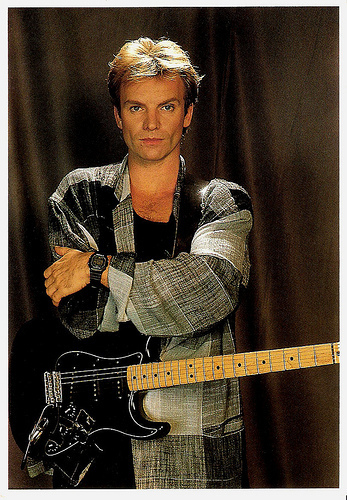
French postcard by Carlton Cards / Santoro Graphics, no. CR33.
Englishman in New York
In 1981, Sting made his first live solo appearance, performing on all four nights of the fourth Amnesty International benefit The Secret Policeman's Other Ball at the invitation of producer Martin Lewis. He performed solo versions of Roxanne and Message in a Bottle. He also led The Secret Police, an all-star band including Eric Clapton, Jeff Beck, Phil Collins, Bob Geldof and Midge Ure on his own arrangement of Bob Dylan's I Shall Be Released. His performances were featured prominently in the album and film of the show and drew critical attention to his work.
Sting's participation in The Secret Policeman's Other Ball was the beginning of his growing involvement in raising money and consciousness for political and social causes. In 1982 he released a solo single, Spread a Little Happiness from the film version of the Dennis Potter television play Brimstone and Treacle. The song was a re-interpretation of a song from the 1920s musical Mr. Cinders by Vivian Ellis, and was a surprise Top 20 hit in the UK.
He also co-starred in the science fiction film Dune (David Lynch, 1984). With a budget of over 40 million dollars, Dune required 80 sets built on 16 sound stages and a total crew of 1700. The film was not well received by critics and performed poorly at the box-office. His following film was The Bride (Franc Roddam, 1985), an adaptation of Mary Shelley's Frankenstein. Sting starred as Baron Charles Frankenstein and Jennifer Beals played a woman he creates in the same fashion as his infamous monster. Both films flopped and damaged Sting’s prospects as a major film star.
A minor success was the Meryl Streep vehicle Plenty (Fred Schepisi, 1985), in which Sting had only a supporting part. His first solo album, The Dream of the Blue Turtles (1985), included the hit singles If You Love Somebody Set Them Free and Russians. The album reached Triple Platinum and would garner Sting a Grammy nomination for Album of the Year. He performed with Dire Straits at the Live Aid Concert at Wembley Stadium. Prior to the Live Aid concert, in November 1984 Sting performed Do They Know It's Christmas? with Band Aid for the relief of poverty in Africa. In 1987, Sting released ...Nothing Like the Sun, including the hit songs Fragile, Englishman in New York, and Be Still My Beating Heart. It eventually went Double Platinum. In 1988, he featured in the role of the soldier on an album of Igor Stravinsky's The Soldier's Tale with the London Sinfonietta conducted by Kent Nagano. It also featured Vanessa Redgrave and Sir Ian McKellen.
On screen he appeared in the atmospheric thriller Stormy Monday (Mike Figgis, 1988), co-starring with Sean Bean, Tommy Lee Jones, and Melanie Griffith. He also co-starred in the Italian drama film Giulia e Giulia/Julia and Julia (Peter Del Monte, 1987) with Kathleen Turner and Gabriel Byrne. This film, presented at the Venice Film Festival in 1987, was the first feature shot using the Sony HDVS wideband analogue High-definition video technique and then transferred to 35 mm film.

French postcard by Media Com +, no. G. 2. Photo: Ed. Gil.
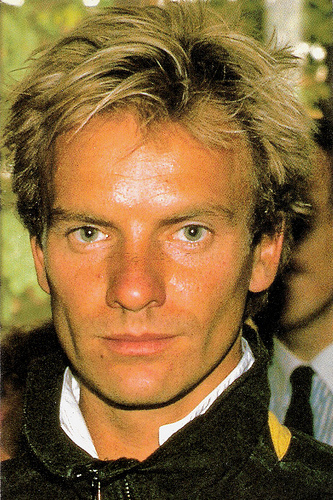
British postcard by Heroes, London, no. SPC618.
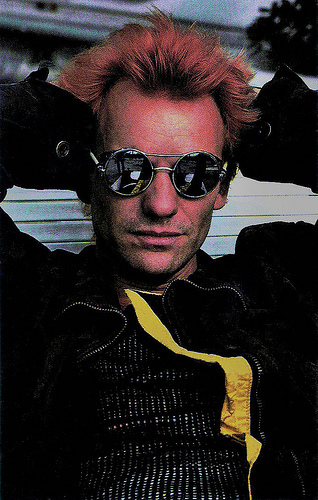
American postcard by Coral-Lee, Rancho Cordova, CA., Personality #131.
Bisexual Butler
Sting’s 1991 album The Soul Cages included the Top 10 song All This Time, and the Grammy-winning The Soul Cages. The album eventually went Platinum. The following year, he married film producer Trudie Styler. In 1993, he released the album Ten Summoner's Tales, which peaked at number two in the UK and US Album Charts, and went triple platinum in just over a year. A hit single on the album was If I Ever Lose My Faith in You, which earned Sting his second Grammy Award. In 1993, he released a cover of his own Police song Demolition Man from the Ghost in the Machine album for the film Demolition Man (Marco Brambilla, 1993).
Together with Bryan Adams and Rod Stewart, Sting performed the chart-topping song All for Love for the film The Three Musketeers (Stephen Herek, 1993). The song stayed at the top of the US charts for five weeks and went Platinum. In 1995 he played a bisexual butler in the British film The Grotesque (John-Paul Davidson, 1995) with Alan Bates, Lena Headey and Theresa Russell. His nude scenes were the highlights of that film, according to an IMDb reviewer. His 1996 album, Mercury Falling debuted strongly with the single Let Your Soul Be Your Pilot, but it dropped quickly on the charts.
Sting was also recording music for the upcoming Disney film Kingdom of the Sun, which went on to be reworked into The Emperor's New Groove (Mark Dindal, 2000). The film went through drastic overhauls and plot changes, many of which were documented by his wife, Trudie Styler. She captured the moment he was called by Disney who then informed him that his songs would not be used in the final film. The story was put into a final product: The Sweatbox, which premiered at the Toronto Film Festival. Disney currently holds the rights to the film and will not grant its release.
More successful was his work on the British crime film Lock, Stock and Two Smoking Barrels (Guy Ritchie, 1998). He played the father of a self-confident young card sharp (Nick Moran) who loses half a million pounds to a powerful crime lord in a card game. He and his friends have one week to come up with the cash. Laura Abraham at AllMovie : “a work of artistic originality as well as an accurate portrayal of life as an Eastender. A rabid, farcical look at gangsters in East End London, it contains mayhem at the center of every scene and gains additional intensity from the slow-motion technique Ritchie employs in many of his death sequences.” The film brought Guy Ritchie international acclaim and introduced former footballer Vinnie Jones, and former street merchant Jason Statham to worldwide cinema audiences.
In 1999, Sting’s album Brand New Day included the Top 40 hits Brand New Day and Desert Rose. The album went Triple Platinum and won two Grammy Awards.

French postcard by Image Media, no. 80 bis.
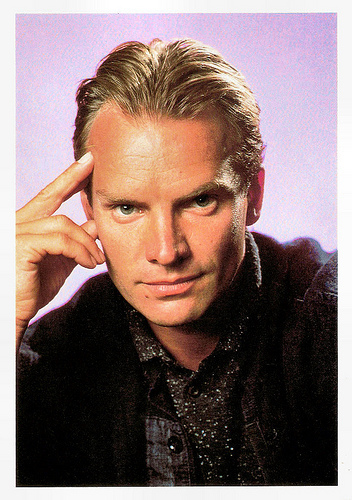
French postcard by Peutsch, no. 964.
Broken Music
In 2002 Sting won a Golden Globe Award for his song Until... from the film Kate and Leopold (James Mangold, 2001). It was also nominated for Academy Award for Best Song. At the 2002 Brit Awards, he received the prize for Outstanding Contribution to Music. Later that year he was inducted into the Songwriters Hall of Fame, was awarded the CBE (Commander of the Order of the British Empire), and won an Emmy Award for his A&E special, Sting in Tuscany... All This Time.
In 2003 he released Sacred Love. He and Mary J. Blige won a Grammy for their album duet, Whenever I Say Your Name. The album did not have the hit singles like his previous releases. However, the album did reach platinum status. His autobiography Broken Music (2003) was published in October. In 2006, he released an album, to mixed reviews, entitled Songs from the Labyrinth featuring the music of English Renaissance composer John Dowland and accompaniment from Bosnian lute player Edin Karamazov.
In 2007, he reunited with the other members of The Police as the introductory act for the 2007 Grammy Awards, singing Roxanne. Subsequently they announced The Police Reunion Tour. The Police toured for more than a year, beginning with North America and eventually crossing over to Europe, South America, Australia & New Zealand and Japan. The last concert was at Madison Square Garden on 7 August 2008, during which his three daughters appeared with him onstage. In 2009 he released a new solo album If on a Winter's Night...
In the cinema he was seen in several film as himself. He had a cameos in the mockumentaries Brüno (Larry Charles, 2009) starring Sacha Baron Cohen as the gay Austrian fashion journalist Brüno, and Do It Again (Robert Patton-Spruill, 2010) which follows Boston Globe reporter Geoff Edgers on his quest to reunite British rock band The Kinks. He also gave his voice to the animation feature Bee Movie (Steve Hickner, Simon J. Smith, 2007).
During his career Sting has received 16 Grammy Awards, three Brit Awards, a Golden Globe, an Emmy Award, and several Oscar nominations for Best Original Song. Sting was married twice, first to actress Frances Tomelty and since 1992 to Trudie Styler. He has six children, two with Tomelty (singer Joseph Sumner (1976) and actress Fuschia Sumner (1982) and four with Styler (Mickey Sumner (1984), Jake Sumner (1985), Coco Sumner (1990) and Giacomo Sumner (1995). Sting owns a Jacobian castle in Wiltshire, a place in London, an apartment in New York, a house on the beach in Malibu, California, and a Renaissance Florentine Villa in Tuscany, Italy.
Criterion Trailer Quadrophenia (Franc Roddam, 1979). Source: Douglas Dutra (YouTube).
Trailer Brimstone and Treacle (Richard Loncraine, 1982). Source: MinervaPicturesGroup (YouTube).
Scene from The Grotesque (John-Paul Davidson, 1995) with Alan Bates and Steven Mackintosh. Source: Elena Gribkova (YouTube).
Trailer Lock, Stock and Two Smoking Barrels (Guy Ritchie, 1998). Source: thecultbox (YouTube).
Sources: Hal Erickson (AllMovie), Mark Deming (AllMovie), Laura Abraham (AllMovie),

British postcard by Statics, no. PC 8. Photo: Lynn Goldsmith.
The Police
Sting was born Gordon Matthew Thomas Sumner in Wallsend, England, in 1951. He was the eldest of four children born to Audrey Sumner née Cowell, a hairdresser, and Ernest Matthew Sumner, a milkman and engineer. His siblings were Philip, Angela and Anita. Young Gordon would often assist his father with the early-morning milk-delivery rounds, and by age 10 he became ‘obsessed’ with an old Spanish guitar that had been left behind by an emigrating friend of his father. He attended St. Cuthbert's Grammar School in Newcastle upon Tyne. He would often sneak into nightclubs like the Club A Go-Go, where he would watch acts such as Cream and Jimi Hendrix, artists who would later influence his own music.
After jobs as a bus conductor, a construction labourer, and a tax officer, he attended Northern Counties College of Education, (later part of Northumbria University) from 1971 to 1974 and qualified as a teacher. He then worked as a schoolteacher at St. Paul's First School in Cramlington for two years. On evenings, weekends, and during breaks from college and from teaching, Sting performed in local jazz bands, played cruise ships, backed strippers in cabarets, and developed a love for the bass guitar. He gained his nickname when he wore a black and gold rugby shirt during a concert. It made him look like a bee, and prompted the nickname ‘Sting’. The nickname stuck.
In 1977, Sting moved from Newcastle to London, and soon thereafter he joined Stewart Copeland and Henry Padovani (who was soon replaced by Andy Summers) to form the New Wave band The Police. Between 1978 and 1983, they released five chart-topping albums and won six Grammy Awards. Although their initial sound was punk inspired, The Police soon switched to reggae-tinged rock and minimalist pop.
Sting also appeared in some British films. He played Ace Face, the leader of the Mod gang in Quadrophenia (Franc Roddam, 1979) starring Phil Daniels. The film, based on the 1973 rock opera by The Who, tells about the rivalry between the Mods and the Rockers in 1960’s England. Mark Deming at AllMovie calls it “intelligent and incisive bit of teen-centric kitchen-sink drama” and writes about Sting: “Equally memorable (is) Sting, who says practically nothing but radiates waves of icy charisma.” His next film Radio On (Christopher Petit, 1979) is a black and white road movie, featuring music by Kraftwerk and David Bowie. A DJ (David Beames) drives from London to Bristol to investigate the suicide of his brother, and on his way he meets some odd people including Sting.
The pitch-black comedy Brimstone and Treacle (Richard Loncraine, 1982) was based on a television play by Dennis Potter. Sting co-starred as a mysterious young stranger who dramatically changes the lives of a middle-aged middle-class couple (Denholm Elliot and Joan Plowright) in a North London suburb whose daughter has been totally dependent upon them after a catastrophic accident. In 1983, the last album of The Police, Synchronicity, was released. It included their most successful song, Every Breath You Take. The song, which after waking up in the middle of the night from a dream, is officially the most requested radio song of all time. While never formally breaking up, after Synchronicity the group agreed to concentrate on solo projects.

British postcard, no. RC 23650. The Police with Andy Summers (left) and Stewart Copeland (right).

French postcard by Carlton Cards / Santoro Graphics, no. CR33.
Englishman in New York
In 1981, Sting made his first live solo appearance, performing on all four nights of the fourth Amnesty International benefit The Secret Policeman's Other Ball at the invitation of producer Martin Lewis. He performed solo versions of Roxanne and Message in a Bottle. He also led The Secret Police, an all-star band including Eric Clapton, Jeff Beck, Phil Collins, Bob Geldof and Midge Ure on his own arrangement of Bob Dylan's I Shall Be Released. His performances were featured prominently in the album and film of the show and drew critical attention to his work.
Sting's participation in The Secret Policeman's Other Ball was the beginning of his growing involvement in raising money and consciousness for political and social causes. In 1982 he released a solo single, Spread a Little Happiness from the film version of the Dennis Potter television play Brimstone and Treacle. The song was a re-interpretation of a song from the 1920s musical Mr. Cinders by Vivian Ellis, and was a surprise Top 20 hit in the UK.
He also co-starred in the science fiction film Dune (David Lynch, 1984). With a budget of over 40 million dollars, Dune required 80 sets built on 16 sound stages and a total crew of 1700. The film was not well received by critics and performed poorly at the box-office. His following film was The Bride (Franc Roddam, 1985), an adaptation of Mary Shelley's Frankenstein. Sting starred as Baron Charles Frankenstein and Jennifer Beals played a woman he creates in the same fashion as his infamous monster. Both films flopped and damaged Sting’s prospects as a major film star.
A minor success was the Meryl Streep vehicle Plenty (Fred Schepisi, 1985), in which Sting had only a supporting part. His first solo album, The Dream of the Blue Turtles (1985), included the hit singles If You Love Somebody Set Them Free and Russians. The album reached Triple Platinum and would garner Sting a Grammy nomination for Album of the Year. He performed with Dire Straits at the Live Aid Concert at Wembley Stadium. Prior to the Live Aid concert, in November 1984 Sting performed Do They Know It's Christmas? with Band Aid for the relief of poverty in Africa. In 1987, Sting released ...Nothing Like the Sun, including the hit songs Fragile, Englishman in New York, and Be Still My Beating Heart. It eventually went Double Platinum. In 1988, he featured in the role of the soldier on an album of Igor Stravinsky's The Soldier's Tale with the London Sinfonietta conducted by Kent Nagano. It also featured Vanessa Redgrave and Sir Ian McKellen.
On screen he appeared in the atmospheric thriller Stormy Monday (Mike Figgis, 1988), co-starring with Sean Bean, Tommy Lee Jones, and Melanie Griffith. He also co-starred in the Italian drama film Giulia e Giulia/Julia and Julia (Peter Del Monte, 1987) with Kathleen Turner and Gabriel Byrne. This film, presented at the Venice Film Festival in 1987, was the first feature shot using the Sony HDVS wideband analogue High-definition video technique and then transferred to 35 mm film.

French postcard by Media Com +, no. G. 2. Photo: Ed. Gil.

British postcard by Heroes, London, no. SPC618.

American postcard by Coral-Lee, Rancho Cordova, CA., Personality #131.
Bisexual Butler
Sting’s 1991 album The Soul Cages included the Top 10 song All This Time, and the Grammy-winning The Soul Cages. The album eventually went Platinum. The following year, he married film producer Trudie Styler. In 1993, he released the album Ten Summoner's Tales, which peaked at number two in the UK and US Album Charts, and went triple platinum in just over a year. A hit single on the album was If I Ever Lose My Faith in You, which earned Sting his second Grammy Award. In 1993, he released a cover of his own Police song Demolition Man from the Ghost in the Machine album for the film Demolition Man (Marco Brambilla, 1993).
Together with Bryan Adams and Rod Stewart, Sting performed the chart-topping song All for Love for the film The Three Musketeers (Stephen Herek, 1993). The song stayed at the top of the US charts for five weeks and went Platinum. In 1995 he played a bisexual butler in the British film The Grotesque (John-Paul Davidson, 1995) with Alan Bates, Lena Headey and Theresa Russell. His nude scenes were the highlights of that film, according to an IMDb reviewer. His 1996 album, Mercury Falling debuted strongly with the single Let Your Soul Be Your Pilot, but it dropped quickly on the charts.
Sting was also recording music for the upcoming Disney film Kingdom of the Sun, which went on to be reworked into The Emperor's New Groove (Mark Dindal, 2000). The film went through drastic overhauls and plot changes, many of which were documented by his wife, Trudie Styler. She captured the moment he was called by Disney who then informed him that his songs would not be used in the final film. The story was put into a final product: The Sweatbox, which premiered at the Toronto Film Festival. Disney currently holds the rights to the film and will not grant its release.
More successful was his work on the British crime film Lock, Stock and Two Smoking Barrels (Guy Ritchie, 1998). He played the father of a self-confident young card sharp (Nick Moran) who loses half a million pounds to a powerful crime lord in a card game. He and his friends have one week to come up with the cash. Laura Abraham at AllMovie : “a work of artistic originality as well as an accurate portrayal of life as an Eastender. A rabid, farcical look at gangsters in East End London, it contains mayhem at the center of every scene and gains additional intensity from the slow-motion technique Ritchie employs in many of his death sequences.” The film brought Guy Ritchie international acclaim and introduced former footballer Vinnie Jones, and former street merchant Jason Statham to worldwide cinema audiences.
In 1999, Sting’s album Brand New Day included the Top 40 hits Brand New Day and Desert Rose. The album went Triple Platinum and won two Grammy Awards.

French postcard by Image Media, no. 80 bis.

French postcard by Peutsch, no. 964.
Broken Music
In 2002 Sting won a Golden Globe Award for his song Until... from the film Kate and Leopold (James Mangold, 2001). It was also nominated for Academy Award for Best Song. At the 2002 Brit Awards, he received the prize for Outstanding Contribution to Music. Later that year he was inducted into the Songwriters Hall of Fame, was awarded the CBE (Commander of the Order of the British Empire), and won an Emmy Award for his A&E special, Sting in Tuscany... All This Time.
In 2003 he released Sacred Love. He and Mary J. Blige won a Grammy for their album duet, Whenever I Say Your Name. The album did not have the hit singles like his previous releases. However, the album did reach platinum status. His autobiography Broken Music (2003) was published in October. In 2006, he released an album, to mixed reviews, entitled Songs from the Labyrinth featuring the music of English Renaissance composer John Dowland and accompaniment from Bosnian lute player Edin Karamazov.
In 2007, he reunited with the other members of The Police as the introductory act for the 2007 Grammy Awards, singing Roxanne. Subsequently they announced The Police Reunion Tour. The Police toured for more than a year, beginning with North America and eventually crossing over to Europe, South America, Australia & New Zealand and Japan. The last concert was at Madison Square Garden on 7 August 2008, during which his three daughters appeared with him onstage. In 2009 he released a new solo album If on a Winter's Night...
In the cinema he was seen in several film as himself. He had a cameos in the mockumentaries Brüno (Larry Charles, 2009) starring Sacha Baron Cohen as the gay Austrian fashion journalist Brüno, and Do It Again (Robert Patton-Spruill, 2010) which follows Boston Globe reporter Geoff Edgers on his quest to reunite British rock band The Kinks. He also gave his voice to the animation feature Bee Movie (Steve Hickner, Simon J. Smith, 2007).
During his career Sting has received 16 Grammy Awards, three Brit Awards, a Golden Globe, an Emmy Award, and several Oscar nominations for Best Original Song. Sting was married twice, first to actress Frances Tomelty and since 1992 to Trudie Styler. He has six children, two with Tomelty (singer Joseph Sumner (1976) and actress Fuschia Sumner (1982) and four with Styler (Mickey Sumner (1984), Jake Sumner (1985), Coco Sumner (1990) and Giacomo Sumner (1995). Sting owns a Jacobian castle in Wiltshire, a place in London, an apartment in New York, a house on the beach in Malibu, California, and a Renaissance Florentine Villa in Tuscany, Italy.
Criterion Trailer Quadrophenia (Franc Roddam, 1979). Source: Douglas Dutra (YouTube).
Trailer Brimstone and Treacle (Richard Loncraine, 1982). Source: MinervaPicturesGroup (YouTube).
Scene from The Grotesque (John-Paul Davidson, 1995) with Alan Bates and Steven Mackintosh. Source: Elena Gribkova (YouTube).
Trailer Lock, Stock and Two Smoking Barrels (Guy Ritchie, 1998). Source: thecultbox (YouTube).
Sources: Hal Erickson (AllMovie), Mark Deming (AllMovie), Laura Abraham (AllMovie),
Published on August 11, 2013 23:00
August 10, 2013
Françoise Arnoul
Cute and sexy actress Françoise Arnoul (1931) was in the early 1950s presented as the new French sex symbol. Soon she was overshadowed by the spectacular Brigitte Bardot, but Arnoul had enough talent and range to forge a decent film career for herself.
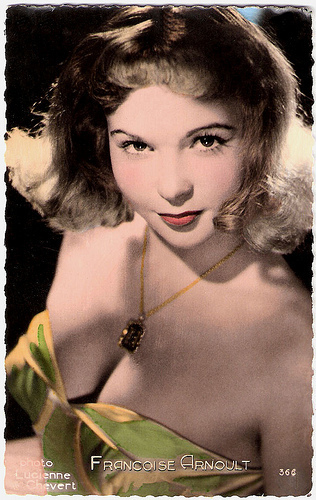
French postcard by Editions P.I., Paris, no. 366. Photo: Lucienne Chevert.
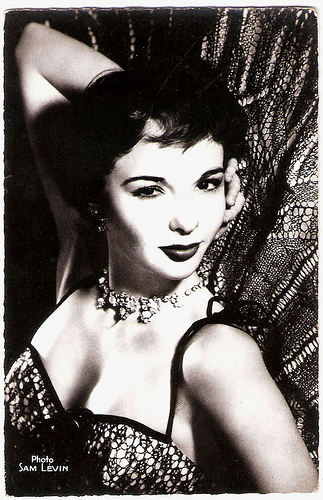
French postcard by Edition du Globe, no. 429. Photo: Sam Lévin.
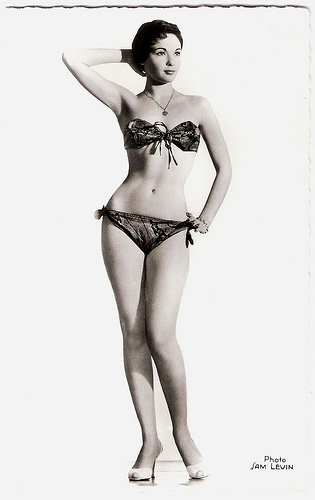 French postcard by Editions du Globe, no. 617. Photo: Sam Lévin, Paris.
French postcard by Editions du Globe, no. 617. Photo: Sam Lévin, Paris.
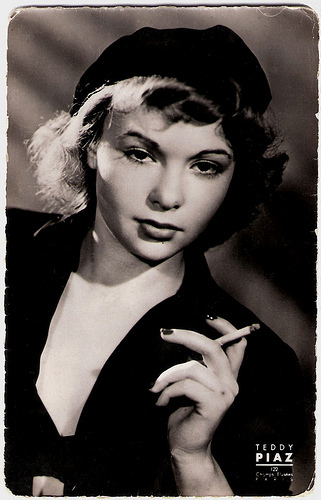
French postcard by Editions du Globe, Paris, no. 113. Photo: Teddy Piaz, Paris.
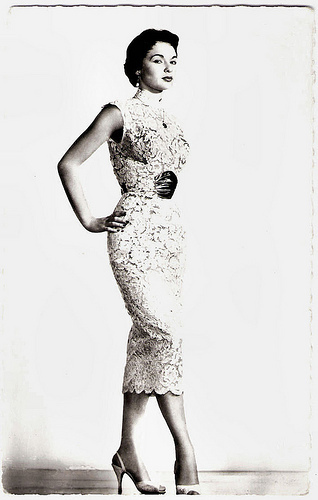
French postcard by Edition du Globe, no. 355.
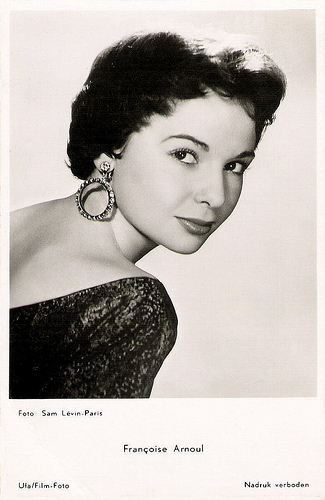
Dutch postcard by Gebr. Spanjersberg N.V., Rotterdam (Dutch licency holder of Ufa (Universum-Film Aktiengesellschaft, Berlin-Tempelhof), no. 1110. Photo: Sam Lévin, Paris.
Undressed Scenes
Françoise Arnoul was born as Françoise Annette Marie Mathilde Gautsch in Constantine, France (now Algeria), in 1931. Her father was a general in the army, Charles Gautsch; her mother was a former stage actress, Jeanne Gradwohl, who worked before her marriage under the name of Jeanne Henry. Françoise grew up in Rabat and Casablanca, and after WWII she returned to Paris. Her mother proved to be a valuable support when her daughter expressed a desire to take courses in drama. She attended the drama classes of Andree Bauer-Thérond, and made her film debut as an extra in Rendez-vous de juillet/Rendezvous in July (Jacques Becker, 1949). Her first bigger role was in L'Épave/Sin and Desire (Willy Rozier, 1949) in which she had some undressed scenes. It made her a star overnight. She was touted as the newest French sex symbol in films like Nous irons à Paris/We Will All Go to Paris (Jean Boyer, 1950) opposite nice and attractive Philippe Lemaire. In the morally rigid 1950s she played sexy and sensuous characters, that were also often troubled and destructive. She was the perverse femme fatale in films like the Georges Siménon adaptation Le Fruit défendu/Forbidden Fruit (Henri Verneuil, 1952) in which she seduces a country doctor played by Fernandel, La Rage au corps/Tempest in the Flesh (Ralph Habib, 1953) in which she is the unfaithful wife of Raymond Pellegrin, and especially in the wildly successful film noir La Chatte/The Cat (Henri Decoin, 1958) in which she played a black leather clad resistance fighter during World War II. Arnoul made of her questioning scene by the Nazis an erotic extravaganza as she slowly removes her stockings under the officer's lecherous eyes.
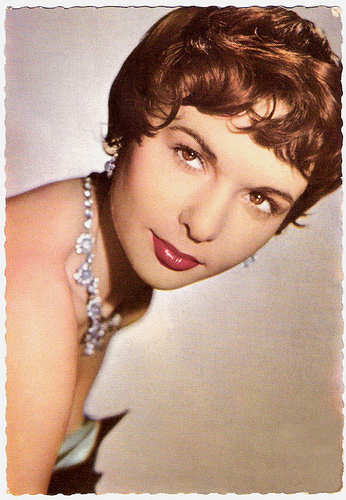
German postcard by Ufa, Berlin-Tempelhof, no. CK-1. Photo: Unifrance Film.
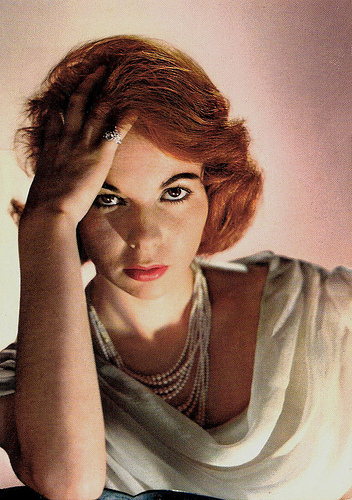
French postcard by Editions P.I.. Paris, no. 1055. Photo: Sam Lévin.
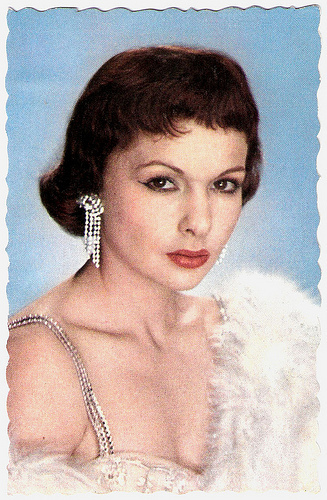
French postcard by Imp. De Marchi Frères, Marseille.
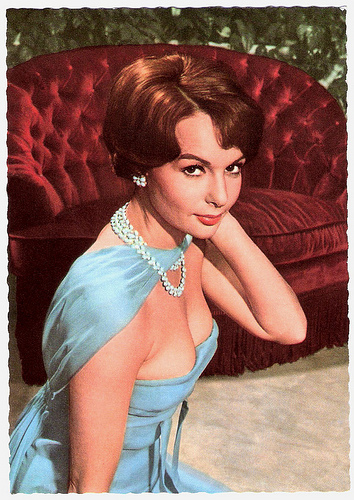
German postcard by Ufa, Berlin-Tempelhof, no. CK-288. Photo: Klaus Collignon / Ufa.
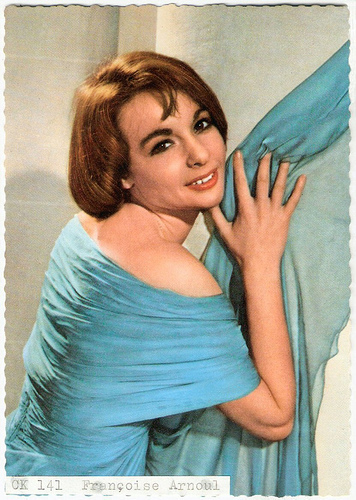
German postcard by Universum-Film Aktiengesellschaft (Ufa), Berlin-Tempelhof, no. CK 141. Photo: Klaus Collignon / Ufa.
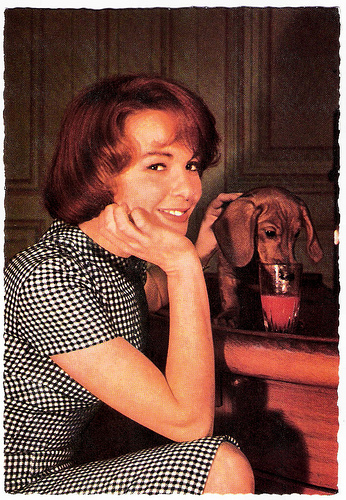
German postcard by WS-Druck, Wanne-Eickel, no. F 105. Photo: Ringpress / Union / Vogelmann.
Animal Endowed with Happiness
The unusually pretty and petite Françoise Arnoul proved her talent and range in such highly regarded films as Michelangelo Antonioni’s episode film I Vinti/The Vanquished (1953), the wonderful Fernandel comedy Le Mouton à cinq pattes/The Sheep Has Five Legs (Henri Verneuil, 1954), and Jean Cocteau's Le Testament d'Orphee/The Testament of Orpheus (1960). In Jean Renoir's French Cancan/French Can-Can (1955) she played Nini, a young laundress from Montmartre, who conquers the Moulin Rouge with her sexy dance. In 1964, during the shooting of Compartiment tueurs/The Sleeping Car Murder (1965, Costa-Gavras), she met director Bernard Paul who would become her life partner. From 1956 till 1960, she had been married to publicity agent Georges Cravenne (the future father of the César and Mollière awards). In the following years she focussed on assisting Paul with his first films. Together with Marina Vlady, they founded in 1968 the production company Francina, that would produce films like Dernière sortie avant Roissy/Last Exit Before Roissy (Bernard Paul, 1977). Paul died in 1980. His loss affected Francoise dearly and she had difficulty to regain a foothold in the cinema. During the 1970s her film career had tapered off, but she appeared in Raul Ruiz’ Diálogos de exiliados/Dialogues of the Exiled (1975) and Violette & François (Jacques Rouffio, 1977) as the mother of Violette (Isabelle Adjani). She also had some success as a television actress. In the late 1990s, Françoise Arnoul returned on the screen in character roles in such films as Temps de Chien/Dog Days (Jean Marboeuf, 1996), Post coitum animal triste/Smell of Geraniums (Brigitte Roüan, 1997) and Merci pour le geste/Thanks for the Gesture (Claude Faraldo, 2000). She published her autobiography entitled Animal doué de Bonheur (Animal Endowed with Happiness) in 1995. In 1997, she was the president of the jury of the Caméra d'Or at the Cannes Film festival. Françoise Arnoul lives in Paris and is still active as a TV actress. In his bio at Les Gens de Cinéma , Yvan Foucart writes: "The young vamp has given way to a blooming woman whose wonderful face radiates serenity. She kept her beautiful smile, her eyes still have the same sparkle and she kept an admirably slim silhouette. (...) So, dear Francoise, you understand why we can not forget you. And why we are still in love with you."
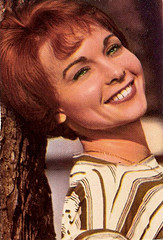
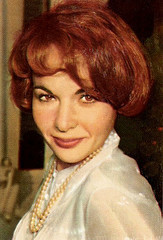
Belgian collector's card, no. 9; Collector's card, no. 98.
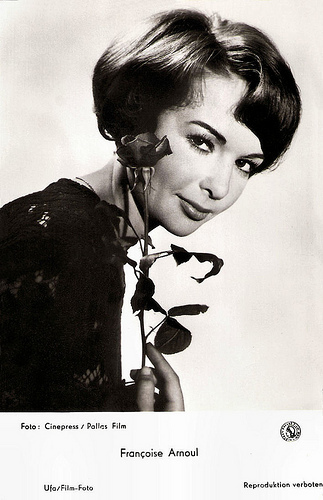
German postcard by Ufa, Berlin. Retail price: 25 Pfg. Photo: Cinepress / Pallas Film.
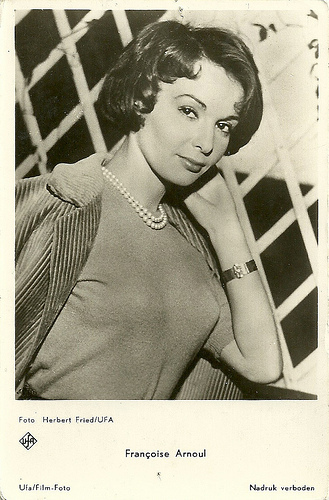
Dutch version of a German postcard by Ufa/Film-Foto. Photo Herbert Fried / Ufa.
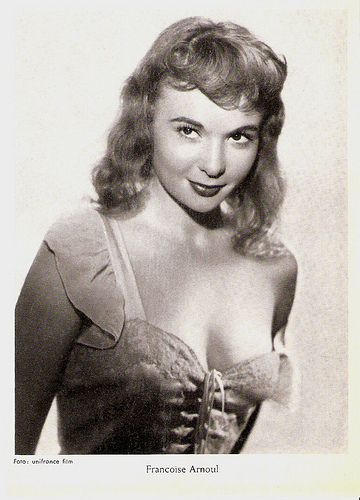
German postcard. Photo: Unifrance film.
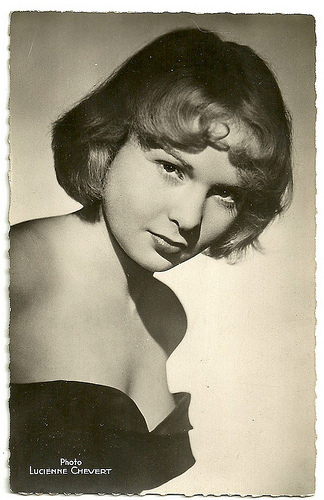
French postcard by Editions du Globe, Paris. Photo: Lucienne Chevert.
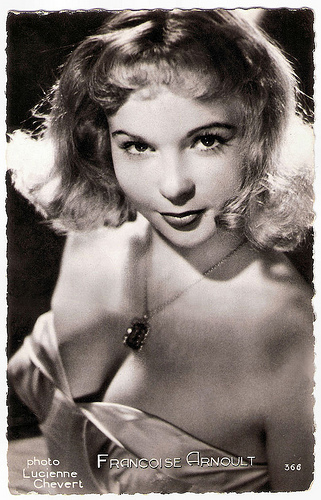
French postcard by Editions P.I., Paris, no. 366. Photo: Lucienne Chevert.
Scene from French Can-Can (1955). Source: ROBAGGIO (YouTube).
Sources: Yvan Foucart (Les Gens de Cinéma) (French), Sandra Brennan (AllMovie), AlloCiné (French), Wikipedia, and

French postcard by Editions P.I., Paris, no. 366. Photo: Lucienne Chevert.

French postcard by Edition du Globe, no. 429. Photo: Sam Lévin.
 French postcard by Editions du Globe, no. 617. Photo: Sam Lévin, Paris.
French postcard by Editions du Globe, no. 617. Photo: Sam Lévin, Paris.
French postcard by Editions du Globe, Paris, no. 113. Photo: Teddy Piaz, Paris.

French postcard by Edition du Globe, no. 355.

Dutch postcard by Gebr. Spanjersberg N.V., Rotterdam (Dutch licency holder of Ufa (Universum-Film Aktiengesellschaft, Berlin-Tempelhof), no. 1110. Photo: Sam Lévin, Paris.
Undressed Scenes
Françoise Arnoul was born as Françoise Annette Marie Mathilde Gautsch in Constantine, France (now Algeria), in 1931. Her father was a general in the army, Charles Gautsch; her mother was a former stage actress, Jeanne Gradwohl, who worked before her marriage under the name of Jeanne Henry. Françoise grew up in Rabat and Casablanca, and after WWII she returned to Paris. Her mother proved to be a valuable support when her daughter expressed a desire to take courses in drama. She attended the drama classes of Andree Bauer-Thérond, and made her film debut as an extra in Rendez-vous de juillet/Rendezvous in July (Jacques Becker, 1949). Her first bigger role was in L'Épave/Sin and Desire (Willy Rozier, 1949) in which she had some undressed scenes. It made her a star overnight. She was touted as the newest French sex symbol in films like Nous irons à Paris/We Will All Go to Paris (Jean Boyer, 1950) opposite nice and attractive Philippe Lemaire. In the morally rigid 1950s she played sexy and sensuous characters, that were also often troubled and destructive. She was the perverse femme fatale in films like the Georges Siménon adaptation Le Fruit défendu/Forbidden Fruit (Henri Verneuil, 1952) in which she seduces a country doctor played by Fernandel, La Rage au corps/Tempest in the Flesh (Ralph Habib, 1953) in which she is the unfaithful wife of Raymond Pellegrin, and especially in the wildly successful film noir La Chatte/The Cat (Henri Decoin, 1958) in which she played a black leather clad resistance fighter during World War II. Arnoul made of her questioning scene by the Nazis an erotic extravaganza as she slowly removes her stockings under the officer's lecherous eyes.

German postcard by Ufa, Berlin-Tempelhof, no. CK-1. Photo: Unifrance Film.

French postcard by Editions P.I.. Paris, no. 1055. Photo: Sam Lévin.

French postcard by Imp. De Marchi Frères, Marseille.

German postcard by Ufa, Berlin-Tempelhof, no. CK-288. Photo: Klaus Collignon / Ufa.

German postcard by Universum-Film Aktiengesellschaft (Ufa), Berlin-Tempelhof, no. CK 141. Photo: Klaus Collignon / Ufa.

German postcard by WS-Druck, Wanne-Eickel, no. F 105. Photo: Ringpress / Union / Vogelmann.
Animal Endowed with Happiness
The unusually pretty and petite Françoise Arnoul proved her talent and range in such highly regarded films as Michelangelo Antonioni’s episode film I Vinti/The Vanquished (1953), the wonderful Fernandel comedy Le Mouton à cinq pattes/The Sheep Has Five Legs (Henri Verneuil, 1954), and Jean Cocteau's Le Testament d'Orphee/The Testament of Orpheus (1960). In Jean Renoir's French Cancan/French Can-Can (1955) she played Nini, a young laundress from Montmartre, who conquers the Moulin Rouge with her sexy dance. In 1964, during the shooting of Compartiment tueurs/The Sleeping Car Murder (1965, Costa-Gavras), she met director Bernard Paul who would become her life partner. From 1956 till 1960, she had been married to publicity agent Georges Cravenne (the future father of the César and Mollière awards). In the following years she focussed on assisting Paul with his first films. Together with Marina Vlady, they founded in 1968 the production company Francina, that would produce films like Dernière sortie avant Roissy/Last Exit Before Roissy (Bernard Paul, 1977). Paul died in 1980. His loss affected Francoise dearly and she had difficulty to regain a foothold in the cinema. During the 1970s her film career had tapered off, but she appeared in Raul Ruiz’ Diálogos de exiliados/Dialogues of the Exiled (1975) and Violette & François (Jacques Rouffio, 1977) as the mother of Violette (Isabelle Adjani). She also had some success as a television actress. In the late 1990s, Françoise Arnoul returned on the screen in character roles in such films as Temps de Chien/Dog Days (Jean Marboeuf, 1996), Post coitum animal triste/Smell of Geraniums (Brigitte Roüan, 1997) and Merci pour le geste/Thanks for the Gesture (Claude Faraldo, 2000). She published her autobiography entitled Animal doué de Bonheur (Animal Endowed with Happiness) in 1995. In 1997, she was the president of the jury of the Caméra d'Or at the Cannes Film festival. Françoise Arnoul lives in Paris and is still active as a TV actress. In his bio at Les Gens de Cinéma , Yvan Foucart writes: "The young vamp has given way to a blooming woman whose wonderful face radiates serenity. She kept her beautiful smile, her eyes still have the same sparkle and she kept an admirably slim silhouette. (...) So, dear Francoise, you understand why we can not forget you. And why we are still in love with you."


Belgian collector's card, no. 9; Collector's card, no. 98.

German postcard by Ufa, Berlin. Retail price: 25 Pfg. Photo: Cinepress / Pallas Film.

Dutch version of a German postcard by Ufa/Film-Foto. Photo Herbert Fried / Ufa.

German postcard. Photo: Unifrance film.

French postcard by Editions du Globe, Paris. Photo: Lucienne Chevert.

French postcard by Editions P.I., Paris, no. 366. Photo: Lucienne Chevert.
Scene from French Can-Can (1955). Source: ROBAGGIO (YouTube).
Sources: Yvan Foucart (Les Gens de Cinéma) (French), Sandra Brennan (AllMovie), AlloCiné (French), Wikipedia, and
Published on August 10, 2013 23:00
August 9, 2013
Lily Damita
Beautiful and seductive French actress Lily Damita (1902-1994) appeared in 33 French, Austrian and Hollywood films between 1922 and 1937. Her marriage with Errol Flynn was tempestuous and led to her nicknames 'Tiger Lil' and 'Dynamita'. In 1970 her only son, Sean Flynn, went missing during the Vietnam war. Lily reportedly invested millions to recover him, but sadly she never found her son back.
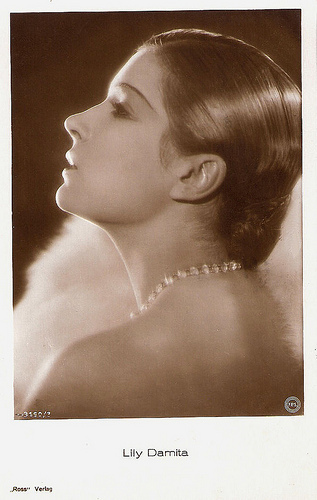
German postcard by Ross Verlag, no. 3150/3, 1928-1929. Photo: F.P.S.
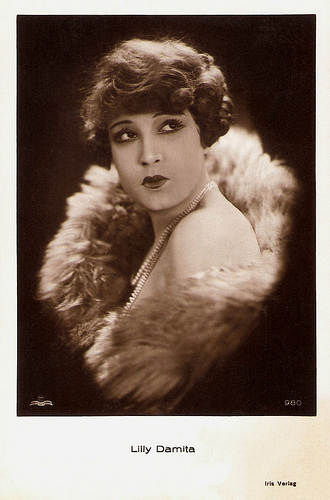
Austrian postcard by Iris Verlag, no. 980. Photo: Sascha-Film.
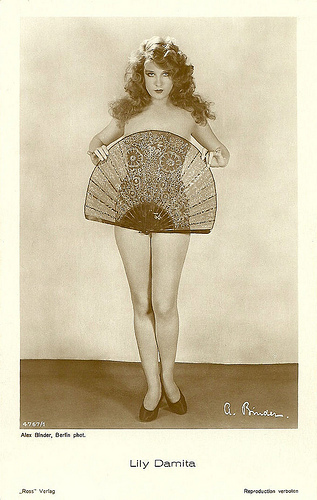
German postcard by Ross Verlag, no. 4767/1, 1929-1930. Photo: Alex Binder, Berlin. Collection: Didier Hanson.
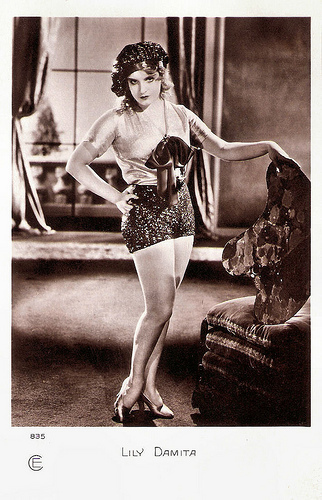
French postcard by Cinémagazine-Selection, Paris, no. 835.
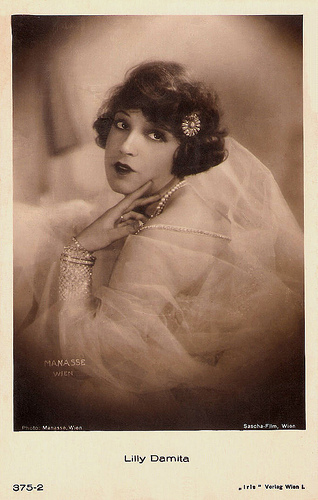
Austrian postcard by Iris Verlag, no. 375/2. Photo: Manassé, Wien / Sascha Film, Wien.
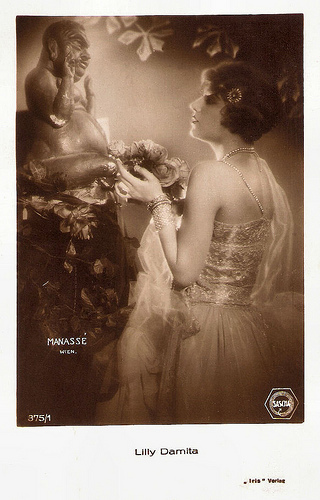
Austrian postcard by Iris Verlag, no. 375/1. Photo: Manassé, Wien / Sascha.
A Life of Mundanity
Lily (also Lili) Damita was born Liliane Marie-Madeleine Carré in Blaye, France (north of Bordeaux), in 1902 (some sources say 1901, 1904 or 1906). She was educated in convents and ballet schools in several European countries, including France, Spain and Portugal. At 14, she was enrolled as a dancer at the Opéra de Paris. By the age of 16 she was performing in popular music-halls, eventually appearing in the Revue at the Casino de Paris under the name Lily Deslys. She also worked as a photographic model. Then a life of mundanity started. When in Biarritz, the Spanish King wanted to be presented to that 'damita dal maillo rojo' (that litte lady in the red bathing costume). Lily liked the compliment so much that she kept her nickname and appeared under the name Damita del Rojo. In 1921 she won a beauty contest by the journal Cinémagazine. The French company Société Cinématographique offered her a role in the silent film La belle au bois dormant/Sleeping Beauty (Stéphane Passet, 1922). She was praised for her beauty and freshness in this film. Soon other French films followed, including the serial L'Empereur des pauvres/The Emperor of the Poor (René Leprince, 1922), La Voyante/The Clairvoyant (Leon Abrams, Louis Mercanton, 1923) with the legendary Sarah Bernhardt, and the drama Corsica (René Carrère, Vanina Casalonga, 1923).
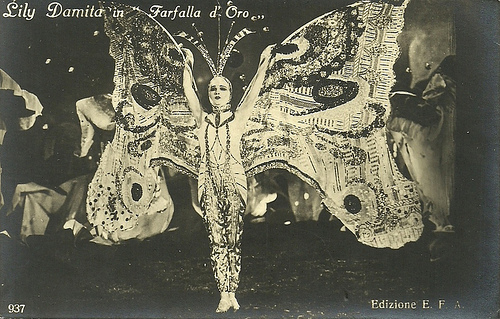
Italian postcard by Edizione E.F.A., no. 937. Photo: Lily Damita in the Austrian silent film Die goldene Schmetterling (Michael Curtiz, 1926).
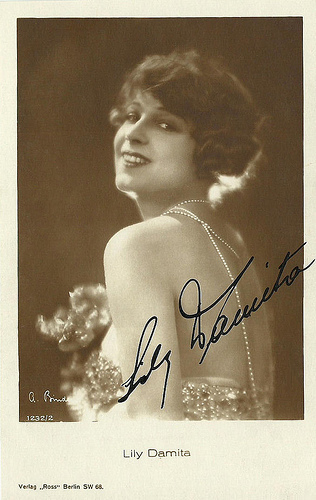
German postcard by Ross Verlag, no. 1232/2, 1927-1928. Photo: Alex Binder, Berlin. Collection: Didier Hanson
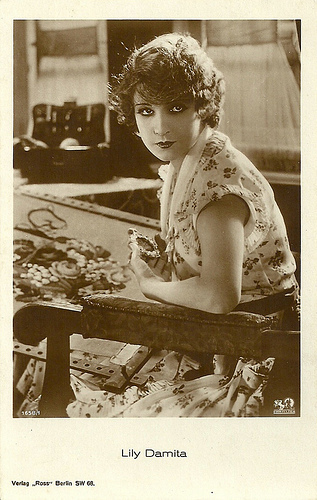
German postcard by Ross Verlag, no. 1658/1, 1927-1928. Photo: Phoebus-Film.
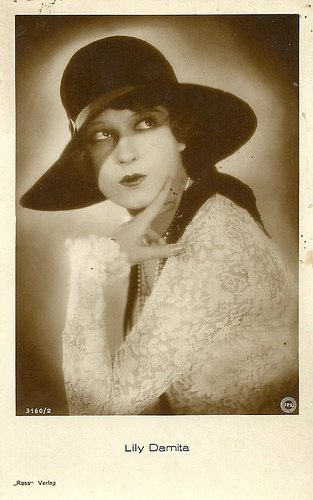
German postcard by Ross Verlag, no. 3160/2, 1928-1929. Photo: F.P.S.
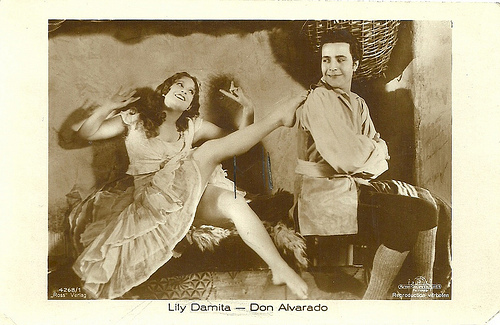
German postcard by Ross Verlag, no. 4268/1, 1929-1930. Photo: Metro-Goldwyn-Mayer. Lily Damita and Don Alvarado in The Bridge of San Luis Rey (Charles Brabin, 1929). The film was shot both as a silent and a sound film.
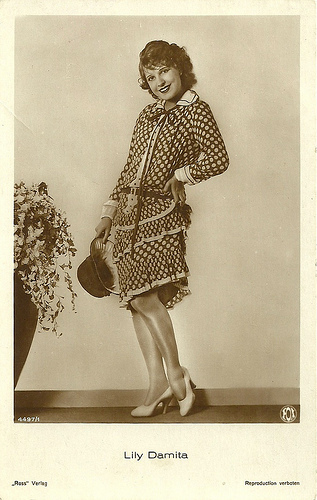
German postcard by Ross Verlag, no. 4497/1, 1929-1930. Photo: Fox.
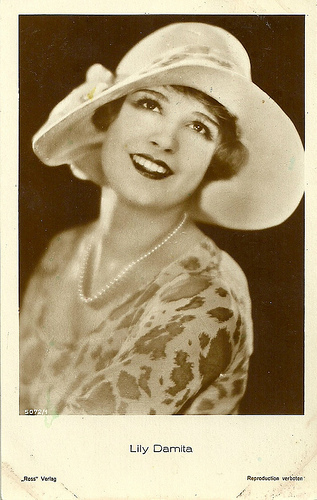
German postcard by Ross Verlag, no. 5072/1, 1930-1931.
A Fabulous Offer
Lily Damita went to Vienna to act next to Max Linder in Der Zirkuskönig but left the role to Vilma Banky. Instead she played in Mihaly Kertesz' (the later Michael Curtiz) Das Spielzeug von Paris/Red Heels (1925), which knew a huge international success. At the time, she was reportedly engaged to Prince Louis Ferdinand of Prussia, grandson of the ex-Kaiser. Count Kolowrat, owner of the Viennese Sascha Film, made her a fabulous offer, partly on instigation of the prince: directors to choose by herself, scripts written especially for her, and ways to turn her into one of Europe's biggest film stars. Thus happened. Lily's films may not have reached canonical film history but they were huge hits at the box office. They included Fiaker Nr. 13/Cab Nr. 13 (1926) and Der goldene Schmetterling/The Golden Butterfly (1926), both directed by Michael Curtiz. The latter film, based on a story by P.G. Wodehouse and largely shot in London, probably contained one of Lily's best performances. She and Curtiz married in 1925 and divorced a year later. Damita continued appearing in European productions directed by G. W. Pabst (Man Spielt nicht mit der Liebe/One Does Not Play with Love; 1926), British director Graham Cutts (The Queen Was in the Parlour; 1927), and Robert Wiene (Die Grosse Abenteuerin/The Amateur Adventure; 1928).
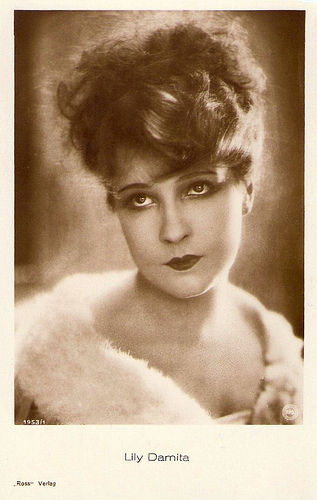
German postcard by Ross Verlag, no. 1953/1, 1927-1928. Photo: EPS.
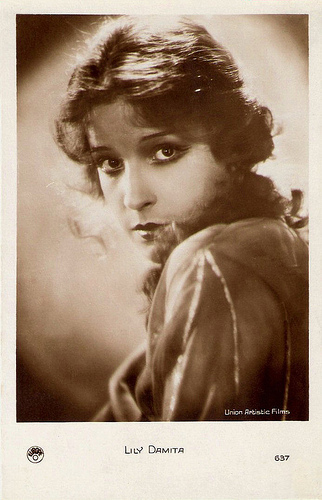
French postcard in the Europe series, no. 637. Photo: Union Artistic Films.
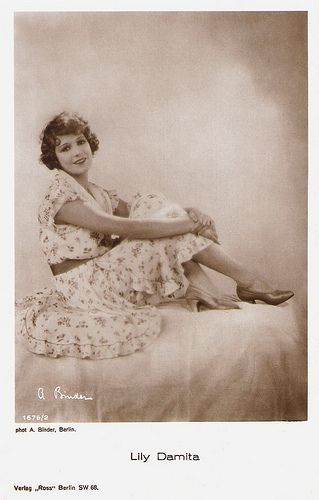
German postcard by Ross Verlag, no. 1676/2, 1927-1928. Photo: A. Binder, Berlin.
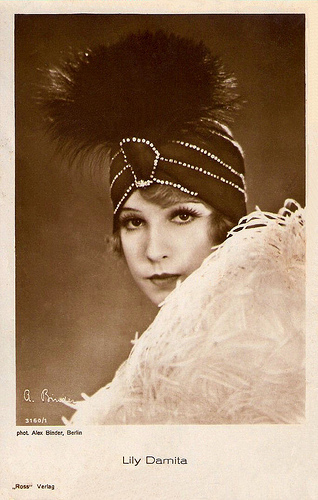
German postcard by Ross Verlag, no. 3160/1, 1928-1929. Photo: Alex Binder, Berlin.
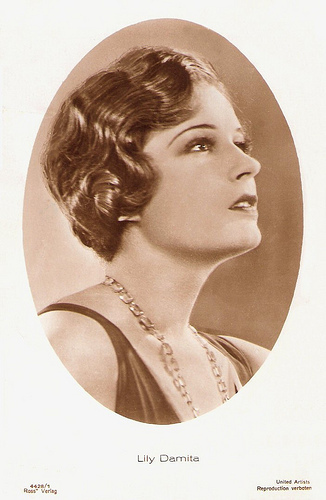
German postcard by Ross Verlag, no. 4428/1, 1929-1930. Photo: United Artists.
A Siren of the Tropics
After several Hollywood offers, it was MGM mogul Sam Goldwyn who took Lily Damita to California to perform in The Rescue (Herbert Brenon, 1929) with Ronald Colman, and The Bridge of San Luis Rey (1929, Charles Brabin), which were rather tedious. Things went better when Lily played a siren of the tropics in The Cock-Eyed World (Raoul Walsh, 1929) opposite Victor McLaglen. In the meantime, sound cinema had arrived. Lily didn't master English too well, so she was put in French versions of American films before dubbing became normal. She was cast with the young Gary Cooper in the early western Fighting Caravans (Otto Brower, David Burton, 1931), and with the young Laurence Olivier in Friends and Lovers (Victor Schertzinger, 1931). She returned to France and played a young adventuress in On a Vole un Homme/Man Stolen (1933) from the great Max Ophüls. According to Hal Erickson at All Movie, this lighthearted romance was "gorgeously photographed on the French Riviera and other such eye-catching locations". On a Vole un Homme was the first of a brace of films produced in France by Erich Pommer on behalf of Hollywood's Fox Films. In 1935 Lily married an unknown actor who would become Hollywood's biggest box office attraction, Errol Flynn. She reportedly retired without complaints, but their marriage was rather tempestuous, hit the press and finished in a divorce in 1942. In 1970, their only son Sean Flynn, a 28 years old photo journalist for Time Magazine and a dead ringer for his father, went missing in Cambodia during the Vietnam war. He was captured by Khmer Rouge guerrillas. In spite of huge investments by Lily, he was never found and in 1984 he was declared legally dead. Lily married three times, the last time to retired dairy owner Allen Loomis (1962-1983). All three marriages ended in a divorce. In 1994, Lily Damita died of Alzheimer's disease in Palm Beach, Florida, aged 89. In March 2010 media reported that remains, that may be those of Sean Flynn (1941-1970), have been found in a mass grave in Cambodia. Tests were scheduled to be conducted on the jaw and femur bone found and were handed over to the U.S. embassy in Phnom Penh. However, the results, released June 30, 2010 by JPAC, showed the remains were not those of Sean Flynn.
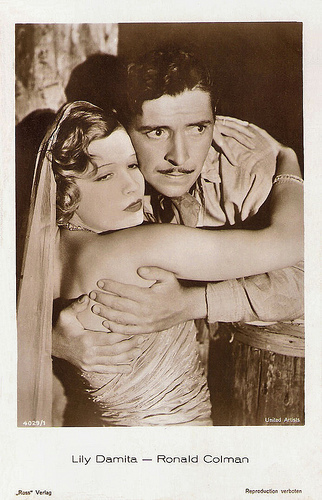
German postcard by Ross Verlag, no. 4029/1, 1929-1930. Photo: United Artists.
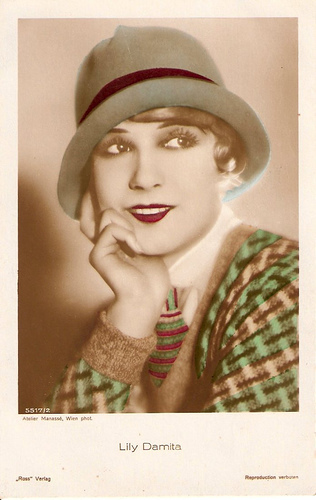
German postcard by Ross Verlag, no. 5517/2, 1930-1931. Photo: Atelier Manassé, Wien (Vienna).
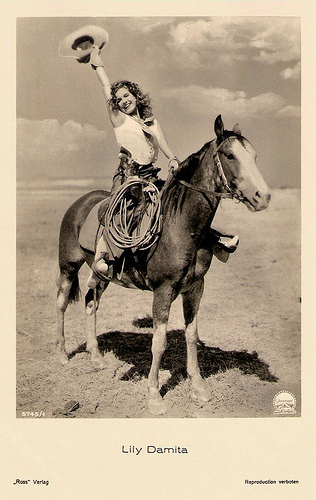
German Postcard by Ross Verlag, no. 5745/1, 1930-1931. Photo: Paramount. Publicity still for Fighting Caravans (1931).
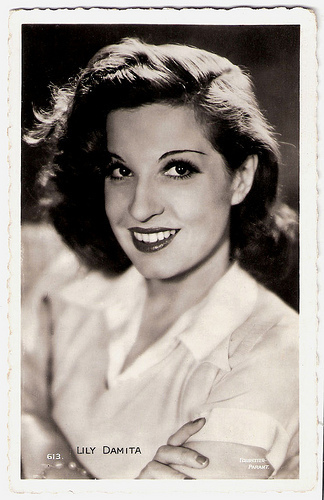
French postcard by Ed. Chantal, Paris, no. 613. Photo: Forrester / Parant.
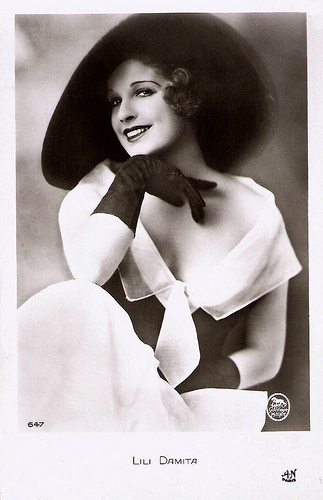
French postcard by A.N., Paris, no. 647. Photo: Metro-Goldwyn-Mayer.
Sources: Vittorio Martinelli (Le dive del silenzio), Hal Erickson (AllMovie), Helen Kennedy (Daily News), C. Parker (Starlet Showcase), Wikipedia, and

German postcard by Ross Verlag, no. 3150/3, 1928-1929. Photo: F.P.S.

Austrian postcard by Iris Verlag, no. 980. Photo: Sascha-Film.

German postcard by Ross Verlag, no. 4767/1, 1929-1930. Photo: Alex Binder, Berlin. Collection: Didier Hanson.

French postcard by Cinémagazine-Selection, Paris, no. 835.

Austrian postcard by Iris Verlag, no. 375/2. Photo: Manassé, Wien / Sascha Film, Wien.

Austrian postcard by Iris Verlag, no. 375/1. Photo: Manassé, Wien / Sascha.
A Life of Mundanity
Lily (also Lili) Damita was born Liliane Marie-Madeleine Carré in Blaye, France (north of Bordeaux), in 1902 (some sources say 1901, 1904 or 1906). She was educated in convents and ballet schools in several European countries, including France, Spain and Portugal. At 14, she was enrolled as a dancer at the Opéra de Paris. By the age of 16 she was performing in popular music-halls, eventually appearing in the Revue at the Casino de Paris under the name Lily Deslys. She also worked as a photographic model. Then a life of mundanity started. When in Biarritz, the Spanish King wanted to be presented to that 'damita dal maillo rojo' (that litte lady in the red bathing costume). Lily liked the compliment so much that she kept her nickname and appeared under the name Damita del Rojo. In 1921 she won a beauty contest by the journal Cinémagazine. The French company Société Cinématographique offered her a role in the silent film La belle au bois dormant/Sleeping Beauty (Stéphane Passet, 1922). She was praised for her beauty and freshness in this film. Soon other French films followed, including the serial L'Empereur des pauvres/The Emperor of the Poor (René Leprince, 1922), La Voyante/The Clairvoyant (Leon Abrams, Louis Mercanton, 1923) with the legendary Sarah Bernhardt, and the drama Corsica (René Carrère, Vanina Casalonga, 1923).

Italian postcard by Edizione E.F.A., no. 937. Photo: Lily Damita in the Austrian silent film Die goldene Schmetterling (Michael Curtiz, 1926).

German postcard by Ross Verlag, no. 1232/2, 1927-1928. Photo: Alex Binder, Berlin. Collection: Didier Hanson

German postcard by Ross Verlag, no. 1658/1, 1927-1928. Photo: Phoebus-Film.

German postcard by Ross Verlag, no. 3160/2, 1928-1929. Photo: F.P.S.

German postcard by Ross Verlag, no. 4268/1, 1929-1930. Photo: Metro-Goldwyn-Mayer. Lily Damita and Don Alvarado in The Bridge of San Luis Rey (Charles Brabin, 1929). The film was shot both as a silent and a sound film.

German postcard by Ross Verlag, no. 4497/1, 1929-1930. Photo: Fox.

German postcard by Ross Verlag, no. 5072/1, 1930-1931.
A Fabulous Offer
Lily Damita went to Vienna to act next to Max Linder in Der Zirkuskönig but left the role to Vilma Banky. Instead she played in Mihaly Kertesz' (the later Michael Curtiz) Das Spielzeug von Paris/Red Heels (1925), which knew a huge international success. At the time, she was reportedly engaged to Prince Louis Ferdinand of Prussia, grandson of the ex-Kaiser. Count Kolowrat, owner of the Viennese Sascha Film, made her a fabulous offer, partly on instigation of the prince: directors to choose by herself, scripts written especially for her, and ways to turn her into one of Europe's biggest film stars. Thus happened. Lily's films may not have reached canonical film history but they were huge hits at the box office. They included Fiaker Nr. 13/Cab Nr. 13 (1926) and Der goldene Schmetterling/The Golden Butterfly (1926), both directed by Michael Curtiz. The latter film, based on a story by P.G. Wodehouse and largely shot in London, probably contained one of Lily's best performances. She and Curtiz married in 1925 and divorced a year later. Damita continued appearing in European productions directed by G. W. Pabst (Man Spielt nicht mit der Liebe/One Does Not Play with Love; 1926), British director Graham Cutts (The Queen Was in the Parlour; 1927), and Robert Wiene (Die Grosse Abenteuerin/The Amateur Adventure; 1928).

German postcard by Ross Verlag, no. 1953/1, 1927-1928. Photo: EPS.

French postcard in the Europe series, no. 637. Photo: Union Artistic Films.

German postcard by Ross Verlag, no. 1676/2, 1927-1928. Photo: A. Binder, Berlin.

German postcard by Ross Verlag, no. 3160/1, 1928-1929. Photo: Alex Binder, Berlin.

German postcard by Ross Verlag, no. 4428/1, 1929-1930. Photo: United Artists.
A Siren of the Tropics
After several Hollywood offers, it was MGM mogul Sam Goldwyn who took Lily Damita to California to perform in The Rescue (Herbert Brenon, 1929) with Ronald Colman, and The Bridge of San Luis Rey (1929, Charles Brabin), which were rather tedious. Things went better when Lily played a siren of the tropics in The Cock-Eyed World (Raoul Walsh, 1929) opposite Victor McLaglen. In the meantime, sound cinema had arrived. Lily didn't master English too well, so she was put in French versions of American films before dubbing became normal. She was cast with the young Gary Cooper in the early western Fighting Caravans (Otto Brower, David Burton, 1931), and with the young Laurence Olivier in Friends and Lovers (Victor Schertzinger, 1931). She returned to France and played a young adventuress in On a Vole un Homme/Man Stolen (1933) from the great Max Ophüls. According to Hal Erickson at All Movie, this lighthearted romance was "gorgeously photographed on the French Riviera and other such eye-catching locations". On a Vole un Homme was the first of a brace of films produced in France by Erich Pommer on behalf of Hollywood's Fox Films. In 1935 Lily married an unknown actor who would become Hollywood's biggest box office attraction, Errol Flynn. She reportedly retired without complaints, but their marriage was rather tempestuous, hit the press and finished in a divorce in 1942. In 1970, their only son Sean Flynn, a 28 years old photo journalist for Time Magazine and a dead ringer for his father, went missing in Cambodia during the Vietnam war. He was captured by Khmer Rouge guerrillas. In spite of huge investments by Lily, he was never found and in 1984 he was declared legally dead. Lily married three times, the last time to retired dairy owner Allen Loomis (1962-1983). All three marriages ended in a divorce. In 1994, Lily Damita died of Alzheimer's disease in Palm Beach, Florida, aged 89. In March 2010 media reported that remains, that may be those of Sean Flynn (1941-1970), have been found in a mass grave in Cambodia. Tests were scheduled to be conducted on the jaw and femur bone found and were handed over to the U.S. embassy in Phnom Penh. However, the results, released June 30, 2010 by JPAC, showed the remains were not those of Sean Flynn.

German postcard by Ross Verlag, no. 4029/1, 1929-1930. Photo: United Artists.

German postcard by Ross Verlag, no. 5517/2, 1930-1931. Photo: Atelier Manassé, Wien (Vienna).

German Postcard by Ross Verlag, no. 5745/1, 1930-1931. Photo: Paramount. Publicity still for Fighting Caravans (1931).

French postcard by Ed. Chantal, Paris, no. 613. Photo: Forrester / Parant.

French postcard by A.N., Paris, no. 647. Photo: Metro-Goldwyn-Mayer.
Sources: Vittorio Martinelli (Le dive del silenzio), Hal Erickson (AllMovie), Helen Kennedy (Daily News), C. Parker (Starlet Showcase), Wikipedia, and
Published on August 09, 2013 23:00
August 8, 2013
Aud Egede Nissen
Norwegian film actress Aud Egede Nissen (1893-1974) was a star of the German silent cinema. During the 1910s, she produced dozens of her own films. In the 1930s she returned to Norway, where she appeared in some films but acted mainly on stage.
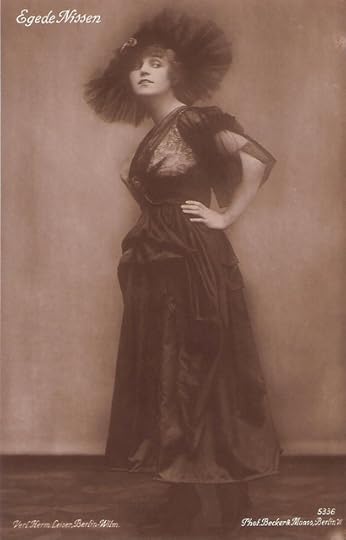
German postcard by Verl. Herm. Leiser, Berlin-Wilm, no. 5336. Photo: Becker & Maas, Berlin-W.
The First Female Detective
Aud Egede Nissen, aka Aud Richter, was born in Bergen, Norway, in 1893. She was the daughter of Norwegian politician Adam Egede-Nissen. Her four younger sisters and two younger brothers would become actors as well. She started her film career in the Danish film Scenens børn/Children of the Stage; or, When Love Speaks (Bjørn Bjørnson, 1913). This film is now believed to be lost.
After four films in Denmark, mostly shorts, she moved to Germany in 1914 and debuted there with the Dania-Film production Um ein Weib/Because of a Woman (Carl Schönfeld, 1914). During the First World War, Nissen had an enormously productive career, changing from one company to another: from Nation Film and the direction of Alfred Halm to Literaria Film with Georg Jacoby directing, from Luna Film with Fred Sauer (who also directed her for Salden Film) to Greenbaum Film with Max Mack. She played a.o. in the serial Homunculus (Otto Rippert, 1916) with Theodoor Loos.
In 1916/1917 she founded her own production company where her husband Georg Alexander directed her in films with herself in the lead. She appeared in more than one film per month (!), including Ich heirate meine Puppe/I Married My Doll (1917), and Das Geheimnis der Briefmarke/The Secret of the Stamp (1917). Very popular was the Ada-van-Ehlers serial. Ada van Ehlers impersonated the first female detective.
Slowly, Egede Nissen became more producer than actress in 1917-1918, though she also continued to act in her own films as well. Nissen’s last own production within this constant and long production line probably was 100.000 Dollars (1919), as always directed by Alexander, though still in 1921 the film Die Idee des Dr. Pax was released, which was a Nissen production as well.
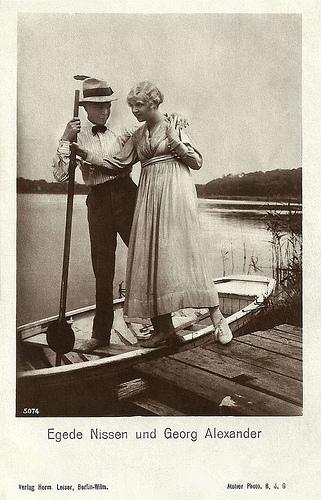
With Georg Alexander. German postcard by Verlag Hermann Leiser, Berlin, no. 5074. Photo: Atelier B.J.G.
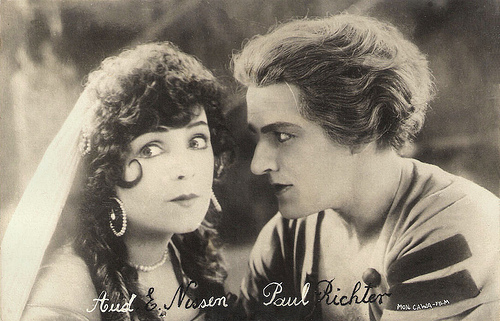
French postcard. Photo: Mon. Cawa-Film. Publicity still for <i>Pietro der Korsar/Peter the Pirate</i> (Arthur Robison, 1925).
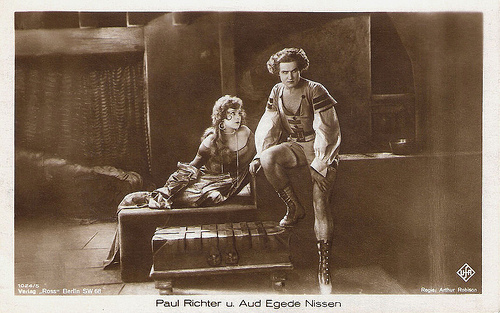
German postcard by Ross Verlag, Berlin, no. 1024/5, 1927-1928. Photo: Ufa. Publicity still for Pietro der Korsar/Peter the Pirate (Arthur Robison, 1925).
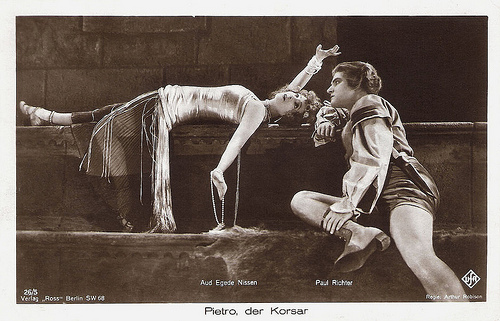
German postcard by Ross Verlag, Berlin, no. 26/5, 1927-1928. Photo: Ufa. Publicity still for Pietro der Korsar/Peter the Pirate (Arthur Robison, 1925).
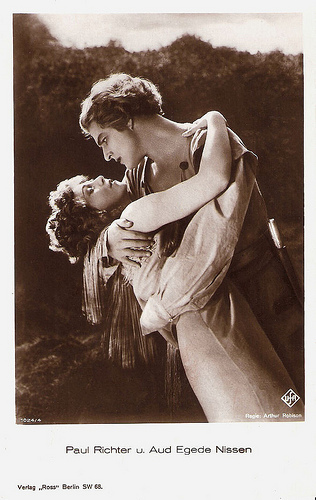
German postcard by Ross Verlag, Berlin, no. 1024/4, 1927-1928. Photo: Ufa. Publicity still for Pietro der Korsar/Peter the Pirate (Arthur Robison, 1925).
Lubitsch, Lang & Murnau
Around 1920. Aud Egede Nissen shifted to performing in major productions. She was Sumurun’s (Pola Negri) servant Haidee in Ernst Lubitsch’s murderous exotic tale Sumurun (1920), the daughter of a merchant freed from Chinese bandits by a reporter in Schiffen und Menschen/Ships and People (Carl Boese, 1920), a female artist in the third sequel to Die Lieblingsfrau der Maharadscha/The Favorite Wife of the Maharadja (Max Mack, 1920), Jane Seymour in Lubitsch’ epic Anna Boleyn (Ernst Lubitsch, 1920), and the dancer Cara Carozza, accomplice to evil hypnotist Mabuse, in Fritz Lang’s thriller Dr. Mabuse, der Spieler/Dr. Mabuse: The Gambler (1921/1922).
In 1922 Nissen was Melanie Lubota, the sister of the main character (Alfred Abel) in F.W. Murnau’s Phantom/The Phantom. In 1923 she was the prostitute in the expressionist drama Die Strasse/The Street (Karl Grune, 1923). The story is about a man, who leaves his wife and humdrum life to seek the excitement of a Parisian street. He spends most of the story chasing after a prostitute thief, which eventually leads him to prison and despair. He then returns to his previous life. In Carlos un Elisabeth (Richard Oswald, 1923), Nissen played Princess Eboli opposite Conrad Veidt.
Later she had the female leads in three realist films by Gerhard Lamprecht: Menschen untereinander (Gerhard Lamprecht, 1925), Die Verrufenen (Gerhard Lamprecht, 1925), and Schwester Veronika (Gerhard Lamprecht, 1925). Other films were the Dutch-German coproduction Droomkoninkje/Die vom Schicksal verfolgten/Little Dream King (Henk Kleinman, 1926), and Die Villa im Tiergarten/The Villa in the Zoo (Franz Osten, 1926).
In such films as Pietro, der Korsar/Pietro the Cossack (Artur Robison, 1925), and Der König der Mittelsturmer/King Of The Centre-forward (1927) she appeared opposite her second husband, Paul Richter. The latter can be considered the first real German soccer feature. In her last silent film, Die Frau im Talar/The Woman in the Robe (Adolf Trotz, 1929), clearly designed for her, Aud Egede Nissen played a female prosecutor in a Norwegian (!) harbour town, who must judge the man she loves (Paul Richter) for a fraud committed by her own father out of despair.
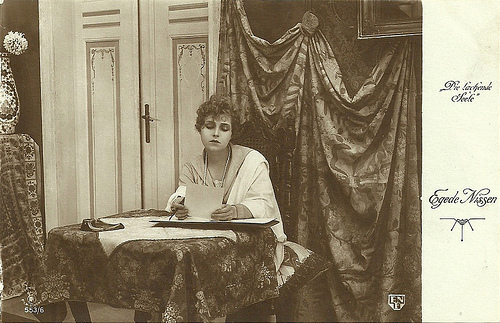
German postcard by Rotophot in the Film-Sterne series, no. 553/6. Photo: ENF. Aud Egede Nissen in the German silent film Die lachende Seele/The Laughing Soul (Georg Alexander, 1919).
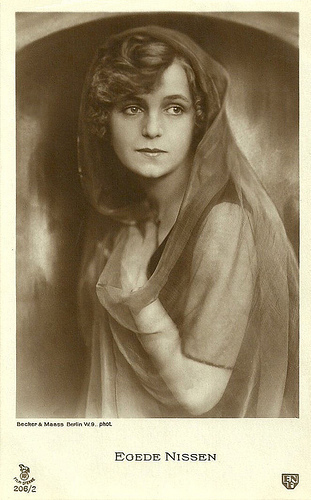
German postcard by Rotophot in the Film-Sterne series, no. 206/2. Photo: Becker & Maass, Berlin / ENF.
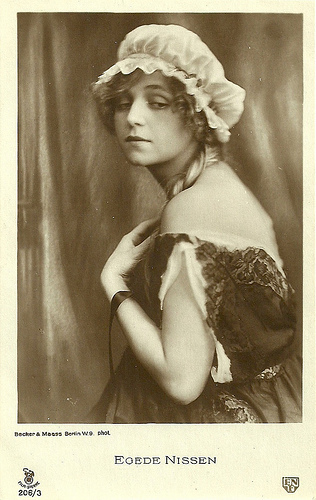
German postcard by Rotophot in the Film-Sterne series, no. 206/3. Photo: Becker & Maass, Berlin / ENF.
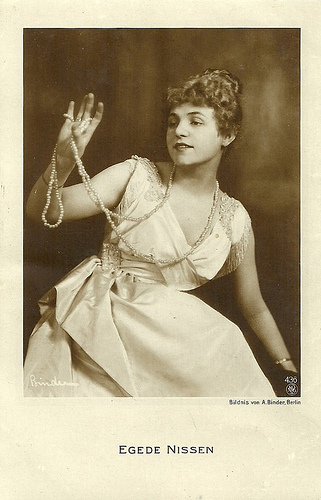
German postcard by NPG, no. 436. Photo: Alex Binder, Berlin.
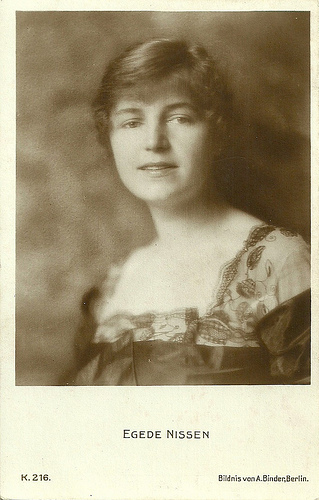
German postcard, no K. 216. Photo: Alex Binder, Berlin.
Back to Norway
Aud Egede Nissen played roles in the German sound film Zwischen Nacht und Morgen/Between Night and Dawn (Gerhard Lamprecht, 1931) opposite Oscar Homolka, and the Danish film Eskimo (Georg Schnéevoigt, 1930), starring Mona Mårtenson. She broke up with Richter and went back to Norway in 1931.
In Norway, her experience was appreciated and she became production leader for two films: En glad gutt (1932) and Syndere i sommersol (1934). She also played small parts in two films during the war years, Hansen og Hansen/Hansen and Hansen (Alfred Maurstad, 1941) and the romantic drama Trysil-Knut/ (Rasmus Breistein, 1942), starring Alfred Maurstad.
During the 1930s Nissen debuted on the Norwegian stage, and played a large amount of roles in 1934-1935, including Hermione in The Winter's Tale (1934) and Gertrud in Hamlet (1935). In 1939 she debuted as theatre director with the play Ansikt til ansikt (Face to Face). In particular between 1955 and 1962 she directed many plays.
Aud Egede Nissen died in Oslo, Norway, in 1974. From 1915 to 1924, she was married to actor-director Georg Alexander. She then married actor Paul Richter whom she divorced in 1931. Her son by Georg Alexander, named after his stepfather Georg Richter, also became an actor and producer. Since 1940 she was married to Dag Havrevold.
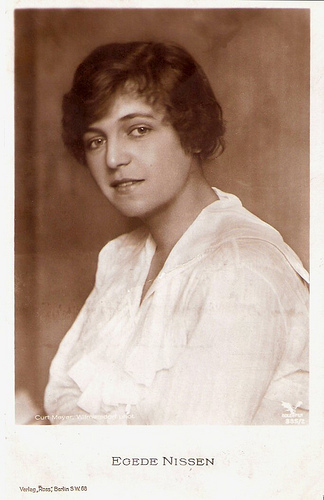
German postcard by Ross Verlag, Berlin, no. 385/2, 1919-1924. Photo: Curt Mayer, Wilmendorf / Adler-Film.
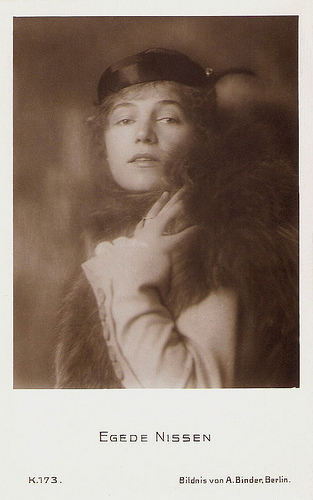
German postcard by Photochemie, Berlin, no. K. 173. Photo: Alex Binder, Berlin.
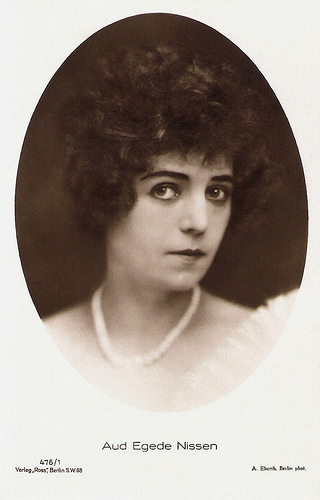
German postcard by Ross Verlag, no. 476/1, 1919-1924. Photo: A. Eberth, Berlin.
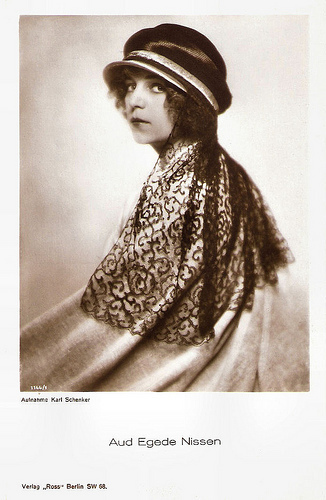
German postcard by Ross Verlag, no. 1144/1, 1927-1928. Photo: Karl Schenker, Berlin.
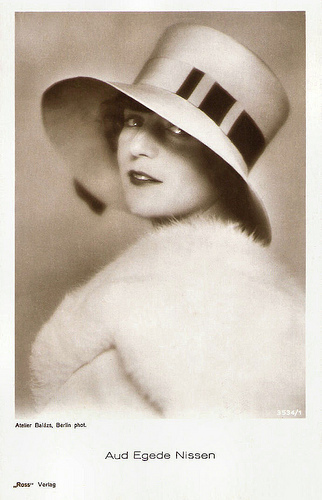
German postcard. by Ross Verlag, Berlin, no. 3534/1, 1928-1929. Photo: Atelier Balázs, Berlin.
Short scene from Phantom/The Phantom (1922). Source: David Holm (YouTube).
Aud Egede Nissen in the silent Norwegian-German crime film Bergenstoget plyndret inatt/Schneeschuhbanditen (Uwe Jenns Krafft, 1928) with Paul Richter. Source: Norskfilminstitutt (YouTube).
Sources: Thomas Staedeli (Cyranos), Filmportal.de (Norwegian), Wikipedia and .

German postcard by Verl. Herm. Leiser, Berlin-Wilm, no. 5336. Photo: Becker & Maas, Berlin-W.
The First Female Detective
Aud Egede Nissen, aka Aud Richter, was born in Bergen, Norway, in 1893. She was the daughter of Norwegian politician Adam Egede-Nissen. Her four younger sisters and two younger brothers would become actors as well. She started her film career in the Danish film Scenens børn/Children of the Stage; or, When Love Speaks (Bjørn Bjørnson, 1913). This film is now believed to be lost.
After four films in Denmark, mostly shorts, she moved to Germany in 1914 and debuted there with the Dania-Film production Um ein Weib/Because of a Woman (Carl Schönfeld, 1914). During the First World War, Nissen had an enormously productive career, changing from one company to another: from Nation Film and the direction of Alfred Halm to Literaria Film with Georg Jacoby directing, from Luna Film with Fred Sauer (who also directed her for Salden Film) to Greenbaum Film with Max Mack. She played a.o. in the serial Homunculus (Otto Rippert, 1916) with Theodoor Loos.
In 1916/1917 she founded her own production company where her husband Georg Alexander directed her in films with herself in the lead. She appeared in more than one film per month (!), including Ich heirate meine Puppe/I Married My Doll (1917), and Das Geheimnis der Briefmarke/The Secret of the Stamp (1917). Very popular was the Ada-van-Ehlers serial. Ada van Ehlers impersonated the first female detective.
Slowly, Egede Nissen became more producer than actress in 1917-1918, though she also continued to act in her own films as well. Nissen’s last own production within this constant and long production line probably was 100.000 Dollars (1919), as always directed by Alexander, though still in 1921 the film Die Idee des Dr. Pax was released, which was a Nissen production as well.

With Georg Alexander. German postcard by Verlag Hermann Leiser, Berlin, no. 5074. Photo: Atelier B.J.G.

French postcard. Photo: Mon. Cawa-Film. Publicity still for <i>Pietro der Korsar/Peter the Pirate</i> (Arthur Robison, 1925).

German postcard by Ross Verlag, Berlin, no. 1024/5, 1927-1928. Photo: Ufa. Publicity still for Pietro der Korsar/Peter the Pirate (Arthur Robison, 1925).

German postcard by Ross Verlag, Berlin, no. 26/5, 1927-1928. Photo: Ufa. Publicity still for Pietro der Korsar/Peter the Pirate (Arthur Robison, 1925).

German postcard by Ross Verlag, Berlin, no. 1024/4, 1927-1928. Photo: Ufa. Publicity still for Pietro der Korsar/Peter the Pirate (Arthur Robison, 1925).
Lubitsch, Lang & Murnau
Around 1920. Aud Egede Nissen shifted to performing in major productions. She was Sumurun’s (Pola Negri) servant Haidee in Ernst Lubitsch’s murderous exotic tale Sumurun (1920), the daughter of a merchant freed from Chinese bandits by a reporter in Schiffen und Menschen/Ships and People (Carl Boese, 1920), a female artist in the third sequel to Die Lieblingsfrau der Maharadscha/The Favorite Wife of the Maharadja (Max Mack, 1920), Jane Seymour in Lubitsch’ epic Anna Boleyn (Ernst Lubitsch, 1920), and the dancer Cara Carozza, accomplice to evil hypnotist Mabuse, in Fritz Lang’s thriller Dr. Mabuse, der Spieler/Dr. Mabuse: The Gambler (1921/1922).
In 1922 Nissen was Melanie Lubota, the sister of the main character (Alfred Abel) in F.W. Murnau’s Phantom/The Phantom. In 1923 she was the prostitute in the expressionist drama Die Strasse/The Street (Karl Grune, 1923). The story is about a man, who leaves his wife and humdrum life to seek the excitement of a Parisian street. He spends most of the story chasing after a prostitute thief, which eventually leads him to prison and despair. He then returns to his previous life. In Carlos un Elisabeth (Richard Oswald, 1923), Nissen played Princess Eboli opposite Conrad Veidt.
Later she had the female leads in three realist films by Gerhard Lamprecht: Menschen untereinander (Gerhard Lamprecht, 1925), Die Verrufenen (Gerhard Lamprecht, 1925), and Schwester Veronika (Gerhard Lamprecht, 1925). Other films were the Dutch-German coproduction Droomkoninkje/Die vom Schicksal verfolgten/Little Dream King (Henk Kleinman, 1926), and Die Villa im Tiergarten/The Villa in the Zoo (Franz Osten, 1926).
In such films as Pietro, der Korsar/Pietro the Cossack (Artur Robison, 1925), and Der König der Mittelsturmer/King Of The Centre-forward (1927) she appeared opposite her second husband, Paul Richter. The latter can be considered the first real German soccer feature. In her last silent film, Die Frau im Talar/The Woman in the Robe (Adolf Trotz, 1929), clearly designed for her, Aud Egede Nissen played a female prosecutor in a Norwegian (!) harbour town, who must judge the man she loves (Paul Richter) for a fraud committed by her own father out of despair.

German postcard by Rotophot in the Film-Sterne series, no. 553/6. Photo: ENF. Aud Egede Nissen in the German silent film Die lachende Seele/The Laughing Soul (Georg Alexander, 1919).

German postcard by Rotophot in the Film-Sterne series, no. 206/2. Photo: Becker & Maass, Berlin / ENF.

German postcard by Rotophot in the Film-Sterne series, no. 206/3. Photo: Becker & Maass, Berlin / ENF.

German postcard by NPG, no. 436. Photo: Alex Binder, Berlin.

German postcard, no K. 216. Photo: Alex Binder, Berlin.
Back to Norway
Aud Egede Nissen played roles in the German sound film Zwischen Nacht und Morgen/Between Night and Dawn (Gerhard Lamprecht, 1931) opposite Oscar Homolka, and the Danish film Eskimo (Georg Schnéevoigt, 1930), starring Mona Mårtenson. She broke up with Richter and went back to Norway in 1931.
In Norway, her experience was appreciated and she became production leader for two films: En glad gutt (1932) and Syndere i sommersol (1934). She also played small parts in two films during the war years, Hansen og Hansen/Hansen and Hansen (Alfred Maurstad, 1941) and the romantic drama Trysil-Knut/ (Rasmus Breistein, 1942), starring Alfred Maurstad.
During the 1930s Nissen debuted on the Norwegian stage, and played a large amount of roles in 1934-1935, including Hermione in The Winter's Tale (1934) and Gertrud in Hamlet (1935). In 1939 she debuted as theatre director with the play Ansikt til ansikt (Face to Face). In particular between 1955 and 1962 she directed many plays.
Aud Egede Nissen died in Oslo, Norway, in 1974. From 1915 to 1924, she was married to actor-director Georg Alexander. She then married actor Paul Richter whom she divorced in 1931. Her son by Georg Alexander, named after his stepfather Georg Richter, also became an actor and producer. Since 1940 she was married to Dag Havrevold.

German postcard by Ross Verlag, Berlin, no. 385/2, 1919-1924. Photo: Curt Mayer, Wilmendorf / Adler-Film.

German postcard by Photochemie, Berlin, no. K. 173. Photo: Alex Binder, Berlin.

German postcard by Ross Verlag, no. 476/1, 1919-1924. Photo: A. Eberth, Berlin.

German postcard by Ross Verlag, no. 1144/1, 1927-1928. Photo: Karl Schenker, Berlin.

German postcard. by Ross Verlag, Berlin, no. 3534/1, 1928-1929. Photo: Atelier Balázs, Berlin.
Short scene from Phantom/The Phantom (1922). Source: David Holm (YouTube).
Aud Egede Nissen in the silent Norwegian-German crime film Bergenstoget plyndret inatt/Schneeschuhbanditen (Uwe Jenns Krafft, 1928) with Paul Richter. Source: Norskfilminstitutt (YouTube).
Sources: Thomas Staedeli (Cyranos), Filmportal.de (Norwegian), Wikipedia and .
Published on August 08, 2013 23:00
Paul van Yperen's Blog
- Paul van Yperen's profile
- 13 followers
Paul van Yperen isn't a Goodreads Author
(yet),
but they
do have a blog,
so here are some recent posts imported from
their feed.



